Transforming Education: A Comprehensive Review of Generative Artificial Intelligence in Educational Settings through Bibliometric and Content Analysis
Abstract
:1. Introduction
2. Methodology
- Literature retrieval—This step entails selecting appropriate search terms and keywords to comprehensively capture pertinent publications related to the intended topic representing the initial and pivotal phase of the data collection process. We retrieved a compilation of pre-existing articles and publications in the domain of GAI in education from the Scopus database. By utilizing a combination of the following keywords, “Education”, “GAI”, “Generative Artificial Intelligence”, “GPT-4”, “ChatGPT”, “AlphaCode”, “GitHub Copilot”, and “Bard”, the authors conducted a targeted search across titles, abstracts, and keyword fields. This process resulted in the enlistment of a total of 437 papers, spanning the years 2018 to 2023.
- Literature screening—The literature screening process for this study drew inspiration from the PRISMA statement, which is widely recognized as a rigorous and transparent approach for conducting systematic reviews and meta-analyses (Figure 1). PRISMA provides a structured framework to ensure the systematic identification, selection, and evaluation of the relevant literature, promoting the reliability and reproducibility of the review process [15]. Initially, a total of 437 papers were retrieved. Following the removal of duplicates, 312 papers remained. After observingly reviewing each publication, all articles that were deemed irrelevant to our research focus were discarded. We narrowed the list down to 217 reviews, papers, and publications that spanned from the years 2018 to 2023. The chronological growth of the papers (in the context of the topic) in the above-mentioned spanned years is depicted in Figure 2.
- c.
- Content analysis—This step entails carefully studying a large amount of information, like research publications, and organizing it in a meaningful way. This helps researchers see common themes and patterns in the information. In this case, the content analysis focused on how GAI is being used in education. The methodology involved categorizing and classifying the research papers into different themes and sub-themes. This organization helps researchers understand the different ways GAI is impacting education, making it easier to draw conclusions and insights from the collected information.
- d.
- Bibliometric analysis—It serves the purpose of systematically evaluating academic literature, typically through analyzing citations and references in research papers. This methodology helps researchers understand the influence, trends, and relationships among different academic works. By examining patterns of citations, co-authorships, and keywords, bibliometric analysis allows for the identification of key authors, influential papers, emerging areas of study, and collaborative networks within a particular field. This approach aids researchers in gaining insights into the evolution of research topics, identifying leading scholars.
3. Content Analysis
3.1. Application of GAI in Computer Science
3.2. Application of GAI in Engineering Education
3.3. Application of GAI in Higher Education
3.4. Application of GAI in Medical Education
3.5. Application of GAI in Nursing Education
3.6. Application of GAI in Communication
3.7. Application of GAI in Academia
3.8. Application of GAI in General Education
4. Bibliometric Analysis
4.1. Co-Occurrence Map Based on Text Data
4.2. Co-Occurrences Map Based on Keywords
4.3. Co-Occurrence Map Based on Country of Co-Authorship
4.4. Co-Occurrence Map Based on Authorship
4.5. Data Analysis on Article Sources
4.6. Data Analysis on Document Type, Fields, GAI Tools Used, and Research Types
5. Conclusions and Future Research
- Exploring Transparency: Future research should focus on enhancing the transparency of GAI models. Understanding how AI-generated outputs are generated and providing transparent explanations to users can increase user trust and acceptance of GAI tools in educational settings;
- Addressing Biases and Fairness: As GAI models learn from existing data, they may inherit biases present in the data, potentially leading to biased outputs. Future research should focus on addressing and mitigating biases in GAI tools, especially in educational contexts, to not perpetuate stereotypes or discriminate against certain groups of learners;
- Designing AI-Enhanced Curriculum: Researchers can explore the potential of GAI in generating adaptive and dynamic learning materials that cater to individual learners’ needs. AI-powered curriculum design can foster personalized and engaging learning experiences, promoting lifelong learning and skill development;
- GAI in Teacher Professional Development: Research can investigate how GAI tools can assist educators in improving their teaching practices, developing tailored instructional materials, and providing real-time feedback on their performance;
- Collaborative AI in Education: Research the potential of collaborative AI systems in education, where humans and AI work together to achieve educational goals;
- Longitudinal Studies: Conduct longitudinal studies to track the long-term effects of GAI integration in education. These studies can provide insights into the sustained impact of GAI on learning outcomes, retention rates, and academic performance over extended periods;
- Privacy and Data Security: Research should focus on developing robust data protection measures and ensuring that student data is handled responsibly and securely;
- Long-term Impact on Learning Outcomes: Investigate the long-term impact of GAI integration on learning outcomes, academic achievement, and students’ problem-solving skills;
- Ethical Considerations and Responsible AI: Further explore the ethical implications of using GAI in education, addressing concerns related to plagiarism, academic integrity, and the potential impact on students’ critical thinking skills. Develop guidelines and policies to ensure the responsible and ethical use of GAI technologies in educational settings;
- Student Acceptance and Adoption: Conduct research on students’ acceptance and adoption of GAI technology in the learning process. Understand factors influencing their attitudes toward AI-powered tools and identify strategies to enhance student engagement and acceptance;
- Interdisciplinary Collaborations: Foster interdisciplinary collaborations between educators, AI researchers, and policymakers to develop comprehensive frameworks for integrating GAI into education;
- Inclusivity and Accessibility: Explore ways to make GAI-powered educational tools more accessible to diverse learners, including those with disabilities or language barriers;
- AI in Assessment and Evaluation: Investigate the effectiveness of GAI in assessment practices, including essay grading, problem-solving evaluation, and personalized feedback;
- AI and Pedagogy: Investigate the implications of GAI for pedagogical practices, examining how it can complement and enhance traditional teaching methods.
Author Contributions
Funding
Data Availability Statement
Acknowledgments
Conflicts of Interest
References
- OpenAI ChatGPT. Available online: https://chat.openai.com (accessed on 28 July 2023).
- Sullivan, M.; Kelly, A.; McLaughlan, P. ChatGPT in higher education: Considerations for academic integrity and student learning. J. Appl. Learn. Teach. 2023, 6, 31–40. [Google Scholar] [CrossRef]
- Bahrini, A.; Khamoshifar, M.; Abbasimehr, H.; Riggs, R.J.; Esmaeili, M.; Majdabadkohne, R.M.; Pasehvar, M. ChatGPT: Applications, opportunities, and threats. In Proceedings of the 2023 Systems and Information Engineering Design Symposium (SIEDS), Charlottesville, VA, USA, 27–28 April 2023. [Google Scholar] [CrossRef]
- Google Bard. Available online: https://bard.google.com/ (accessed on 28 July 2023).
- Github Copilot. Available online: https://copilot.github.com/ (accessed on 28 July 2023).
- Hadi, M.U.; Qureshi, R.; Shah, A.; Irfan, M.; Zafar, A.; Shaikh, M.B.; Akhtar, N.; Wu, J.; Mirjalili, S. A Survey on Large Language Models: Applications, Challenges, Limitations, and Practical Usage. TechRxiv 2023. [Google Scholar] [CrossRef]
- Baidoo-Anu, D.; Owusu Ansah, L. Education in the Era of Generative Artificial Intelligence (AI): Understanding the Potential Benefits of ChatGPT in Promoting Teaching and Learning. Available online: https://ssrn.com/abstract=4337484 (accessed on 28 July 2023).
- Crompton, H.; Burke, D. Artificial intelligence in higher education: The state of the field. Int. J. Educ. Technol. High. Educ. 2023, 20, 22. [Google Scholar] [CrossRef]
- Sallam, M.; Salim, N.; Barakat, M.; Al-Tammemi, A. ChatGPT applications in medical, dental, pharmacy, and public health education: A descriptive study highlighting the advantages and limitations. Narra J. 2023, 3, e103. [Google Scholar] [CrossRef]
- Hsu, M.; Chan, T.; Yu, C. Termbot: A Chatbot-Based Crossword Game for Gamified Medical Terminology Learning. Int. J. Environ. Res. Public Health 2023, 20, 4185. [Google Scholar] [CrossRef]
- MacNeil, S.; Tran, A.; Mogil, D.; Bernstein, S.; Ross, E.; Huang, Z. Generating diverse code explanations using the gpt-3 large language model. In Proceedings of the 2022 ACM Conference on International Computing Education Research, Lugano, Switzerland, 7–11 August 2022; Volume 2. [Google Scholar] [CrossRef]
- Rahman, M.M.; Watanobe, Y. ChatGPT for education and research: Opportunities, threats, and strategies. Appl. Sci. 2023, 13, 5783. [Google Scholar] [CrossRef]
- Kooli, C. Chatbots in education and research: A critical examination of ethical implications and solutions. Sustainability 2023, 15, 5614. [Google Scholar] [CrossRef]
- Markel, J.M.; Opferman, S.G.; Landay, J.A.; Piech, C. GPTeach: Interactive TA Training with GPT Based Students. In Proceedings of the Tenth ACM Conference on Learning @ Scale (L@S ‘23), Association for Computing Machinery, New York, NY, USA, 20–22 July 2023. [Google Scholar]
- Prisma Framework. Available online: http://www.prisma-statement.org/ (accessed on 6 August 2023).
- Jonsson, M.; Tholander, J. Cracking the code: Co-coding with AI in creative programming education. In Proceedings of the 14th Conference on Creativity and Cognition, Venice, Italy, 20–23 June 2022. [Google Scholar] [CrossRef]
- Finnie-Ansley, J.; Denny, P.; Becker, B.A.; Luxton-Reilly, A.; Prather, J. The robots are coming: Exploring the implications of openai codex on introductory programming. In Proceedings of the 24th Australasian Computing Education Conference, Virtual Event, 14–18 February 2022. [Google Scholar] [CrossRef]
- Denny, P.; Kumar, V.; Giacaman, N. Conversing with copilot: Exploring prompt engineering for solving cs1 problems using natural language. In Proceedings of the 54th ACM Technical Symposium on Computer Science Education V. 1, Toronto, ON, Canada, 15–18 March 2023. [Google Scholar] [CrossRef]
- Kazemitabaar, M.; Chow, J.; Ma, C.K.T.; Ericson, B.J.; Weintrop, D.; Grossman, T. Studying the effect of AI code generators on supporting novice learners in introductory programming. In Proceedings of the 2023 CHI Conference on Human Factors in Computing Systems, Hamburg, Germany, 23–28 April 2023. [Google Scholar] [CrossRef]
- Savelka, J.; Agarwal, A.; Bogart, C.; Sakr, M. Large language models (gpt) struggle to answer multiple-choice questions about code. arXiv 2023, arXiv:2303.08033. [Google Scholar]
- Wermelinger, M. Using GitHub copilot to solve simple programming problems. In Proceedings of the 54th ACM Technical Symposium on Computer Science Education V. 1, Toronto, ON, Canada, 15–18 March 2023. [Google Scholar] [CrossRef]
- Becker, B.A.; Denny, P.; Finnie-Ansley, J.; Luxton-Reilly, A.; Prather, J.; Santos, E.A. Programming is hard-or at least it used to be: Educational opportunities and challenges of AI code generation. In Proceedings of the 54th ACM Technical Symposium on Computer Science Education V. 1, Toronto, ON, Canada, 15–18 March 2023. [Google Scholar] [CrossRef]
- Jacques, L. Teaching CS-101 at the Dawn of ChatGPT. ACM Inroads 2023, 14, 40–46. [Google Scholar] [CrossRef]
- Raji, I.D.; Scheuerman, M.K.; Amironesei, R. You can’t sit with us: Exclusionary pedagogy in AI ethics education. In Proceedings of the 2021 ACM Conference on Fairness, Accountability, and Transparency, Virtual Event, 3–10 March 2021. [Google Scholar] [CrossRef]
- Yilmaz, R.; Yilmaz, F.G.K. The effect of generative artificial intelligence (AI)-based tool use on students’ computational thinking skills, programming self-efficacy and motivation. Comput. Educ. Artif. Intell. 2023, 4, 100147. [Google Scholar] [CrossRef]
- Cortiñas-Lorenzo, K.; Lacey, G. Toward Explainable Affective Computing: A Review. IEEE Trans. Neural Netw. Learn. Syst. 2023. accepted. [Google Scholar] [CrossRef] [PubMed]
- Marquez, R.; Barrios, N.; Vera, R.E.; Mendez, M.E.; Tolosa, L.; Zambrano, F.; Li, Y. A perspective on the synergistic potential of artificial intelligence and product-based learning strategies in biobased materials education. Educ. Chem. Eng. 2023, 44, 164–180. [Google Scholar] [CrossRef]
- Humphry, T.; Fuller, A.L. Potential ChatGPT Use in Undergraduate Chemistry Laboratories. J. Chem. Educ. 2023, 100, 1434–1436. [Google Scholar] [CrossRef]
- Sánchez-Ruiz, L.M.; Moll-López, S.; Nuñez-Pérez, A.; Moraño-Fernández, J.A.; Vega-Fleitas, E. ChatGPT Challenges Blended Learning Methodologies in Engineering Education: A Case Study in Mathematics. Appl. Sci. 2023, 13, 6039. [Google Scholar] [CrossRef]
- Nikolic, S.; Daniel, S.; Haque, R.; Belkina, M.; Hassan, G.M.; Grundy, S.; Lyden, S.; Neal, P.; Sandison, C. ChatGPT versus engineering education assessment: A multidisciplinary and multi-institutional benchmarking and analysis of this generative artificial intelligence tool to investigate assessment integrity. Eur. J. Eng. Educ. 2023, 48, 559–614. [Google Scholar] [CrossRef]
- Gmeiner, F.; Yang, H.; Yao, L.; Holstein, K.; Martelaro, N. Exploring challenges and opportunities to support designers in learning to co-create with AI-based manufacturing design tools. In Proceedings of the 2023 CHI Conference on Human Factors in Computing Systems, Hamburg, Germany, 23–28 April 2023. [Google Scholar] [CrossRef]
- Chen, C.; Olajoyegbe, T.O.; Morkos, B. The imminent educational paradigm shift: How artificial intelligence will reframe how we educate the next generation of engineering designers. In Proceedings of the 2020 ASEE Virtual Annual Conference Content Access, Virtual Event, 22–26 June 2020. [Google Scholar] [CrossRef]
- Galdon, F.; Hall, A.; Ferrarello, L. Enhacing abductive reasoning in design and engineering education via probabilistic knowledge; a case study in ai. In Proceedings of the DS 110: 23rd International Conference on Engineering and Product Design Education (E&PDE 2021), VIA Design, VIA University, Herning, Denmark, 9–10 September 2021. [Google Scholar] [CrossRef]
- Elfaki, A.O.; Abduljabbar, M.; Ali, L.; Alnajjar, F.; Mehiar, D.; Marei, A.M.; Alhmiedat, T.; Al-Jumaily, A. Revolutionizing Social Robotics: A Cloud-Based Framework for Enhancing the Intelligence and Autonomy of Social Robots. Robotics 2023, 12, 48. [Google Scholar] [CrossRef]
- Konecki, M.; Konecki, M.; Biškupić, I. Using artificial intelligence in higher education. In Proceedings of the 15th International Conference on Computer Supported Education, Prague, Czech Republic, 21–23 April 2023. [Google Scholar] [CrossRef]
- Eager, B.; Brunton, R. Prompting higher education towards AI-augmented teaching and learning practice. J. Univ. Teach. Learn. Pract. 2023, 20, 02. [Google Scholar] [CrossRef]
- Chaudhry, I.S.; Sarwary, S.A.M.; El Refae, G.A.; Chabchoub, H. Time to Revisit Existing Student’s Performance Evaluation Approach in Higher Education Sector in a New Era of ChatGPT—A Case Study. Cogent Educ. 2023, 10, 2210461. [Google Scholar] [CrossRef]
- Iskender, A. Holy or unholy? Interview with open AI’s ChatGPT. Eur. J. Tour. Res. 2023, 34, 3414. [Google Scholar] [CrossRef]
- Strzelecki, A. To use or not to use ChatGPT in higher education? A study of students’ acceptance and use of technology. Interact. Learn. Environ. 2023, 34, 3414. [Google Scholar] [CrossRef]
- Stojanov, A. Learning with ChatGPT 3.5 as a more knowledgeable other: An autoethnographic study. Int. J. Educ. Technol. High. Educ. 2023, 20, 35. [Google Scholar] [CrossRef]
- Pinto, A.S.; Abreu, A.; Costa, E.; Paiva, J. How Machine Learning (ML) is Transforming Higher Education: A Systematic Literature Review. J. Inf. Syst. Eng. Manag. 2023, 8, 21168. [Google Scholar] [CrossRef]
- Waisberg, E.; Ong, J.; Masalkhi, M.; Kamran, S.A.; Zaman, N.; Sarker, P.; Lee, A.G.; Tavakkoli, A. GPT-4: A new era of artificial intelligence in medicine. Ir. J. Med. Sci. 2023, 1–4. [Google Scholar] [CrossRef]
- Sevgi, U.T.; Erol, G.; Doğruel, Y.; Sönmez, O.F.; Tubbs, R.S.; Güngor, A. The role of an open artificial intelligence platform in modern neurosurgical education: A preliminary study. Neurosurg. Rev. 2023, 46, 86. [Google Scholar] [CrossRef]
- Šlapeta, J. Are ChatGPT and other pretrained language models good parasitologists? Trends Parasitol. 2023, 39, 314–316. [Google Scholar] [CrossRef] [PubMed]
- Huh, S. Are ChatGPT’s knowledge and interpretation ability comparable to those of medical students in Korea for taking a parasitology examination?: A descriptive study. J. Educ. Eval. Health Prof. 2023, 20, 1–6. [Google Scholar] [CrossRef]
- Dolezal, J.M.; Wolk, R.; Hieromnimon, H.M.; Howard, F.M.; Srisuwananukorn, A.; Karpeyev, D.; Ramesh, S.; Kochanny, S.; Kwon, J.W.; Agni, M.; et al. Deep learning generates synthetic cancer histology for explainability and education. NPJ Precis. Oncol. 2023, 7, 49. [Google Scholar] [CrossRef] [PubMed]
- Skalidis, I.; Cagnina, A.; Luangphiphat, W.; Mahendiran, T.; Muller, O.; Abbe, E.; Fournier, S. ChatGPT takes on the European Exam in Core Cardiology: An artificial intelligence success story? Eur. Heart J.-Digit. Health 2023, 4, 279–281. [Google Scholar] [CrossRef] [PubMed]
- Corsello, A.; Santangelo, A. May Artificial Intelligence Influence Future Pediatric Research?—The Case of ChatGPT. Children 2023, 10, 757. [Google Scholar] [CrossRef]
- Lyu, Q.; Tan, J.; Zapadka, M.E.; Ponnatapuram, J.; Niu, C.; Wang, G.; Whitlow, C.T. Translating radiology reports into plain language using chatgpt and gpt-4 with prompt learning: Promising results, limitations, and potential. arXiv 2023, arXiv:2303.09038. [Google Scholar] [CrossRef]
- Abdel-Messih, M.S.; Kamel Boulos, M.N. ChatGPT in clinical toxicology. JMIR Med. Educ. 2023, 9, e46876. [Google Scholar] [CrossRef]
- Oh, N.; Choi, G.; Lee, W.Y. ChatGPT goes to the operating room: Evaluating GPT-4 performance and its potential in surgical education and training in the era of large language models. Ann. Surg. Treat. Res. 2023, 104, 269. [Google Scholar] [CrossRef]
- Lee, P.; Bubeck, S.; Petro, J. Benefits, limits, and risks of GPT-4 as an AI chatbot for medicine. N. Engl. J. Med. 2023, 388, 1233–1239. [Google Scholar] [CrossRef]
- Yang, J.; Por, L.Y.; Leong, M.C.; Ku, C.S. The Potential of ChatGPT in Assisting Children with Down Syndrome. Ann. Biomed. Eng. 2023, 1–3. [Google Scholar] [CrossRef]
- Wang, H.; Jia, S.; Li, Z.; Duan, Y.; Tao, G.; Zhao, Z. A Comprehensive Review of Artificial Intelligence in Prevention and Treatment of COVID-19 Pandemic. Front. Genet. 2022, 13, 845305. [Google Scholar] [CrossRef] [PubMed]
- Cascella, M.; Montomoli, J.; Bellini, V.; Bignami, E. Evaluating the feasibility of ChatGPT in healthcare: An analysis of multiple clinical and research scenarios. J. Med. Syst. 2023, 47, 33. [Google Scholar] [CrossRef] [PubMed]
- Gupta, R.; Herzog, I.; Weisberger, J.; Chao, J.; Chaiyasate, K.; Lee, E.S. Utilization of ChatGPT for plastic surgery research: Friend or foe? J. Plast. Reconstr. Aesthetic Surg. 2023, 80, 145–147. [Google Scholar] [CrossRef] [PubMed]
- Masters, K. Ethical use of artificial intelligence in health professions education: AMEE Guide No. 158. Med. Teach. 2023, 45, 574–584. [Google Scholar] [CrossRef] [PubMed]
- Choi, E.P.H.; Lee, J.J.; Ho, M.; Kwok, J.Y.Y.; Lok, K.Y.W. Chatting or cheating? The impacts of ChatGPT and other artificial intelligence language models on nurse education. Nurse Educ. Today 2023, 125, 105796. [Google Scholar] [CrossRef]
- Irwin, P.; Jones, D.; Fealy, S. What is ChatGPT and what do we do with it? Implications of the age of AI for nursing and midwifery practice and education: An editorial. Nurse Educ. Today 2023, 127, 105835. [Google Scholar] [CrossRef]
- Abdulai, A.; Hung, L. Will ChatGPT undermine ethical values in nursing education, research, and practice. Nurs. Inq. 2023, 30, e12556. [Google Scholar] [CrossRef]
- Seney, V.; Desroches, M.L.; Schuler, M.S. Using ChatGPT to teach enhanced clinical judgment in nursing education. Nurse Educ. 2023, 48, 124. [Google Scholar] [CrossRef]
- Ahmed, S.K. The Impact of ChatGPT on the Nursing Profession: Revolutionizing Patient Care and Education. Ann. Biomed. Eng. 2023, 1–2. [Google Scholar] [CrossRef]
- Lo, L.S. The CLEAR path: A framework for enhancing information literacy through prompt engineering. J. Acad. Librariansh. 2023, 49, 102720. [Google Scholar] [CrossRef]
- Wang, H. Short sequence Chinese-English machine translation based on generative adversarial networks of emotion. Comput. Intell. Neurosci. 2022, 2022, 3385477. [Google Scholar] [CrossRef] [PubMed]
- Santandreu-Calonge, D.; Medina-Aguerrebere, P.; Hultberg, P.; Shah, M. Can ChatGPT improve communication in hospitals? Prof. Inf. 2023, 32, e320219. [Google Scholar] [CrossRef]
- Pavlik, J.V. Collaborating with ChatGPT: Considering the implications of generative artificial intelligence for journalism and media education. J. Mass Commun. Educ. 2023, 78, 84–93. [Google Scholar] [CrossRef]
- Feng, Y.; Poralla, P.; Dash, S.; Li, K.; Desai, V.; Qiu, M. The impact of chatgpt on streaming media: A crowdsourced and data-driven analysis using twitter and reddit. In Proceedings of the 2023 IEEE 9th Intl Conference on Big Data Security on Cloud (BigDataSecurity), IEEE Intl Conference on High Performance and Smart Computing, (HPSC) and IEEE Intl Conference on Intelligent Data and Security (IDS), New York, NY, USA, 6–8 May 2023. [Google Scholar] [CrossRef]
- Alqahtani, T.; Badreldin, H.A.; Alrashed, M.; Alshaya, A.I.; Alghamdi, S.S.; bin Saleh, K.; Alowais, S.A.; Alshaya, O.A.; Rahman, I.; Al Yami, M.S.; et al. The emergent role of artificial intelligence, natural learning processing, and large language models in higher education and research. Res. Soc. Adm. Pharm. 2023, 19, 1236–1242. [Google Scholar] [CrossRef] [PubMed]
- Cotton, D.R.; Cotton, P.A.; Shipway, J.R. Chatting and cheating: Ensuring academic integrity in the era of ChatGPT. Innov. Educ. Teach. Int. 2023, 1–12. [Google Scholar] [CrossRef]
- Currie, G.M. Academic integrity and artificial intelligence: Is ChatGPT hype, hero or heresy? Semin. Nucl. Med. 2023, 53, 719–730. [Google Scholar] [CrossRef]
- Dergaa, I.; Chamari, K.; Zmijewski, P.; Saad, H.B. From human writing to artificial intelligence generated text: Examining the prospects and potential threats of ChatGPT in academic writing. Biol. Sport 2023, 40, 615–622. [Google Scholar] [CrossRef]
- Perkins, M. Academic Integrity considerations of AI Large Language Models in the post-pandemic era: ChatGPT and beyond. J. Univ. Teach. Learn. Pract. 2023, 20, 07. [Google Scholar] [CrossRef]
- Inamdar, S. Impact of artificial intelligence text generators (AITGs) on libraries. Libr. Hi Tech News 2023. ahead-of-print. [Google Scholar] [CrossRef]
- Frederick, D.E. ChatGPT: A viral data-driven disruption in the information environment. Libr. Hi Tech News 2023, 40, 4–10. [Google Scholar] [CrossRef]
- Al Ghatrifi, M.O.M.; Al Amairi, J.S.S.; Thottoli, M.M. Surfing the technology wave: An international perspective on enhancing teaching and learning in accounting. Comput. Educ. Artif. Intell. 2023, 4, 100144. [Google Scholar] [CrossRef]
- Geerling, W.; Mateer, G.D.; Wooten, J.; Damodaran, N. ChatGPT has aced the test of understanding in college economics: Now what? Am. Econ. 2023, 05694345231169654. [Google Scholar] [CrossRef]
- Skavronskaya, L.; Hadinejad, A.; Cotterell, D. Reversing the threat of artificial intelligence to opportunity: A discussion of ChatGPT in tourism education. J. Teach. Travel Tour. 2023, 23, 253–258. [Google Scholar] [CrossRef]
- Elnozahy, W.A.; El Khayat, G.A. Multi-lang question answering framework for decision support in educational institutes. In Proceedings of the 15th International Conference on Computer Supported Education, Prague, Czech Republic, 21–23 April 2023. [Google Scholar] [CrossRef]
- Aydın, N.; Erdem, O.A. A research on the new generation artificial intelligence technology generative pretraining transformer 3. In Proceedings of the 2022 3rd International Informatics and Software Engineering Conference (IISEC), Ankara, Turkey, 15–16 December 2022. [Google Scholar] [CrossRef]
- Cooper, G. Examining science education in chatgpt: An exploratory study of generative artificial intelligence. J. Sci. Educ. Technol. 2023, 32, 444–452. [Google Scholar] [CrossRef]
- Su, J.; Yang, W. Unlocking the power of ChatGPT: A framework for applying generative AI in education. ECNU Rev. Educ. 2023, 20965311231168423. [Google Scholar] [CrossRef]
- Murugesan, S.; Cherukuri, A.K. The Rise of Generative Artificial Intelligence and Its Impact on Education: The Promises and Perils. Computer 2023, 56, 116–121. [Google Scholar] [CrossRef]
- Hsu, Y.; Ching, Y. Generative Artificial Intelligence in Education, Part One: The Dynamic Frontier. TechTrends 2023, 67, 603–607. [Google Scholar] [CrossRef]
- Mørch, A.I.; Andersen, R. Human-Centred AI in Education in the Age of Generative AI Tools. Available online: https://ceur-ws.org/Vol-3408/short-s2-08.pdf (accessed on 14 July 2023).
- Gentile, M.; Città, G.; Perna, S.; Allegra, M. Do we still need teachers? navigating the paradigm shift of the teacher’s role in the AI era. Front. Educ. 2023, 8, 1161777. [Google Scholar] [CrossRef]
- Jangjarat, K.; Kraiwanit, T.; Limna, P.; Sonsuphap, R. Public Perceptions Towards ChatGPT as the Robo-Assistant. Online J. Commun. Media Technol. 2023, 13, e202338. [Google Scholar] [CrossRef]
- Tlili, A.; Shehata, B.; Adarkwah, M.A.; Bozkurt, A.; Hickey, D.T.; Huang, R.; Agyemang, B. What if the devil is my guardian angel: ChatGPT as a case study of using chatbots in education. Smart Learn. Environ. 2023, 10, 15. [Google Scholar] [CrossRef]
- Lodge, J.M.; Thompson, K.; Corrin, L. Mapping out a research agenda for generative artificial intelligence in tertiary education. Australas. J. Educ. Technol. 2023, 39, 1–8. [Google Scholar] [CrossRef]
- Chen, X.; Xie, H.; Zou, D.; Hwang, G. Application and theory gaps during the rise of artificial intelligence in education. Comput. Educ. Artif. Intell. 2020, 1, 100002. [Google Scholar] [CrossRef]
- Luo, W.; He, H.; Liu, J.; Berson, I.R.; Berson, M.J.; Zhou, Y.; Li, H. Aladdin’s Genie or Pandora’s Box for Early Childhood Education? Experts Chat on the Roles, Challenges, and Developments of ChatGPT. Early Educ. Dev. 2023, 2214181. [Google Scholar] [CrossRef]
- Kasneci, E.; Seßler, K.; Küchemann, S.; Bannert, M.; Dementieva, D.; Fischer, F.; Gasser, U.; Groh, G.; Günnemann, S.; Hüllermeier, E.; et al. ChatGPT for good? On opportunities and challenges of large language models for education. Learn. Individ. Differ. 2023, 103, 102274. [Google Scholar] [CrossRef]
- Golovianko, M.; Gryshko, S.; Terziyan, V.; Tuunanen, T. Responsible cognitive digital clones as decision-makers: A design science research study. Eur. J. Inf. Syst. 2022, 1–23. [Google Scholar] [CrossRef]
- Ye, F.; Bors, A.G. Lifelong teacher-student network learning. IEEE Trans. Pattern Anal. Mach. Intell. 2021, 44, 6280–6296. [Google Scholar] [CrossRef]
- Karadag, I.; Güzelci, O.Z.; Alaçam, S. EDU-AI: A twofold machine learning model to support classroom layout generation. Constr. Innov. 2022, 23, 898–914. [Google Scholar] [CrossRef]
- Vartiainen, H.; Tedre, M. Using artificial intelligence in craft education: Crafting with text-to-image generative models. Digit. Creat. 2023, 34, 1–21. [Google Scholar] [CrossRef]
- Zhai, C.; Wibowo, S.; Cowling, M. An innovative tool for education: An adversarial dialogue system embedded with humor, empathy and culture. In Proceedings of the 2023 11th International Conference on Information and Education Technology (ICIET), Fujisawa, Japan, 18–20 March 2023. [Google Scholar] [CrossRef]
- Sarr, J.M.A.; Yannakakis, G.N.; Liapis, A.; Bah, A.; Cambier, C. Djehuty: A mixed-initiative handwriting game for preschoolers. In Proceedings of the 15th International Conference on the Foundations of Digital Games, Bugibba, Malta, 15–18 September 2020. [Google Scholar] [CrossRef]
- Bauer, E.; Greisel, M.; Kuznetsov, I.; Berndt, M.; Kollar, I.; Dresel, M.; Fischer, M.R.; Fischer, F. Using natural language processing to support peer-feedback in the age of artificial intelligence: A cross-disciplinary framework and a research agenda. Br. J. Educ. Technol. 2023, 54, 1222–1245. [Google Scholar] [CrossRef]
- Farrokhnia, M.; Banihashem, S.K.; Noroozi, O.; Wals, A. A SWOT analysis of ChatGPT: Implications for educational practice and research. Innov. Educ. Teach. Int. 2023, 1–15. [Google Scholar] [CrossRef]
- Howell, B.E.; Potgieter, P.H. What do telecommunications policy academics have to fear from GPT-3? Telecommun. Policy 2023, 102576. [Google Scholar] [CrossRef]
- Huang, Y.; Khan, S.M. Advances in AI and machine learning for education research. In Computational Psychometrics: New Methodologies for a New Generation of Digital Learning and Assessment: With Examples in R and Python; Springer: Berlin/Heidelberg, Germany, 2021; pp. 195–208. [Google Scholar] [CrossRef]
- Ibrahim, H.; Asim, R.; Zaffar, F.; Rahwan, T.; Zaki, Y. Rethinking Homework in the Age of Artificial Intelligence. IEEE Intell. Syst. 2023, 38, 24–27. [Google Scholar] [CrossRef]
- Sung, C.; Dhamecha, T.I.; Mukhi, N. Improving short answer grading using transformer-based pre-training. In Proceedings of the Artificial Intelligence in Education: 20th International Conference, AIED 2019, Chicago, IL, USA, 25–29 June 2019. [Google Scholar] [CrossRef]
- Lo, C.K. What is the impact of ChatGPT on education? A rapid review of the literature. Educ. Sci. 2023, 13, 410. [Google Scholar] [CrossRef]
- Ajevski, M.; Barker, K.; Gilbert, A.; Hardie, L.; Ryan, F. ChatGPT and the future of legal education and practice. Law Teach. 2023, 1–13. [Google Scholar] [CrossRef]
- Johinke, R.; Cummings, R.; Di Lauro, F. Reclaiming the technology of higher education for teaching digital writing in a post—Pandemic world. J. Univ. Teach. Learn. Pract. 2023, 20, 01. [Google Scholar] [CrossRef]
- Kovačević, D. Use of chatgpt in ESP teaching process. In Proceedings of the 2023 22nd International Symposium INFOTEH-JAHORINA (INFOTEH), East Sarajevo, Bosnia and Herzegovina, 15–17 March 2023. [Google Scholar] [CrossRef]
- Zhao, T.; Song, T. Establishing a Fusion Model of Attention Mechanism and Generative Adversarial Network to Estimate Students’ Attitudes in English Classes. Teh. Vjesn. 2022, 29, 1464–1471. [Google Scholar] [CrossRef]
- Tang, J.; Deng, Y. The Design Model of English Graded Teaching Assistant Expert System Based on Improved B/S Three-Tier Structure System. Mob. Inf. Syst. 2022, 2022, 4167760. [Google Scholar] [CrossRef]
- O’Leary, D.E. An analysis of three chatbots: BlenderBot, ChatGPT and LaMDA. Intell. Syst. Account. Financ. Manag. 2023, 30, 41–54. [Google Scholar] [CrossRef]
- Yan, D. Impact of ChatGPT on learners in a L2 writing practicum: An exploratory investigation. Educ. Inf. Technol. 2023, 1–25. [Google Scholar] [CrossRef]
- Bearman, M.; Ajjawi, R. Learning to work with the black box: Pedagogy for a world with artificial intelligence. Br. J. Educ. Technol. 2023, 54, 1160–1173. [Google Scholar] [CrossRef]
- Fernandez, P. Through the looking glass: Envisioning new library technologies AI-text generators as explained by ChatGPT. Libr. Hi Tech News 2023, 40, 11–14. [Google Scholar] [CrossRef]
- Ray, P.P. ChatGPT: A comprehensive review on background, applications, key challenges, bias, ethics, limitations and future scope. Internet Things Cyber-Phys. Syst. 2023, 3, 121–154. [Google Scholar] [CrossRef]
- Singh, H.; Singh, A. ChatGPT: Systematic Review, Applications, and Agenda for Multidisciplinary Research. J. Chin. Econ. Bus. Stud. 2023, 21, 193–212. [Google Scholar] [CrossRef]
- Danry, V.; Leong, J.; Pataranutaporn, P.; Tandon, P.; Liu, Y.; Shilkrot, R.; Punpongsanon, P.; Weissman, T.; Maes, P.; Sra, M. AI-generated characters: Putting deepfakes to good use. In Proceedings of the CHI Conference on Human Factors in Computing Systems Extended Abstracts, New Orleans, LA, USA, 29 April–5 May 2022. [Google Scholar] [CrossRef]
- Ali, S.; DiPaola, D.; Lee, I.; Hong, J.; Breazeal, C. Exploring generative models with middle school students. In Proceedings of the 2021 CHI Conference on Human Factors in Computing Systems, Yokohama, Japan, 8–13 May 2021. [Google Scholar] [CrossRef]
- Adams, T.; Jameel, S.M.; Goggins, J. Education for Sustainable Development: Mapping the SDGs to University Curricula. Sustainability 2023, 15, 8340. [Google Scholar] [CrossRef]
- Emenike, M.E.; Emenike, B.U. Was This Title Generated by ChatGPT? Considerations for Artificial Intelligence Text-Generation Software Programs for Chemists and Chemistry Educators. J. Chem. Educ. 2023, 100, 1413–1418. [Google Scholar] [CrossRef]
- Agathokleous, E.; Saitanis, C.J.; Fang, C.; Yu, Z. Use of ChatGPT: What does it mean for biology and environmental science? Sci. Total Environ. 2023, 888, 164154. [Google Scholar] [CrossRef]
- Hallsworth, J.E.; Udaondo, Z.; Pedrós-Alió, C.; Höfer, J.; Benison, K.C.; Lloyd, K.G.; Cordero, R.J.; de Campos, C.B.; Yakimov, M.M.; Amils, R. Scientific novelty beyond the experiment. Microb. Biotechnol. 2023, 16, 1131–1173. [Google Scholar] [CrossRef]
- Megahed, F.M.; Chen, Y.; Ferris, J.A.; Knoth, S.; Jones-Farmer, L.A. How generative AI models such as chatgpt can be (mis) used in spc practice, education, and research? an exploratory study. Qual. Eng. 2023, 1–29. [Google Scholar] [CrossRef]
- Ivanov, S.; Soliman, M. Game of algorithms: ChatGPT implications for the future of tourism education and research. J. Tour. Futures 2023, 9, 214–221. [Google Scholar] [CrossRef]
- Fergus, S.; Botha, M.; Ostovar, M. Evaluating academic answers generated using ChatGPT. J. Chem. Educ. 2023, 100, 1672–1675. [Google Scholar] [CrossRef]
- Siche, R.; Siche, N. El modelo de lenguaje basado en inteligencia artificial sensible-ChatGPT: Análisis bibliométrico y posibles usos en la agricultura y pecuaria. Sci. Agropecu. 2023, 14, 111–116. [Google Scholar] [CrossRef]
- Uddin, S.J.; Albert, A.; Ovid, A.; Alsharef, A. Leveraging ChatGPT to Aid Construction Hazard Recognition and Support Safety Education and Training. Sustainability 2023, 15, 7121. [Google Scholar] [CrossRef]
- Wolfert, R.; van Nederveen, S.; Binnekamp, R. Fit for Purpose Building Information Modelling and Systems Integration (BIMSI) for Better Construction Projects Management. J. Mod. Proj. Manag. 2022, 10, 174–187. [Google Scholar] [CrossRef]
- Wu, R.; Yu, Z. Do AI chatbots improve students learning outcomes? Evidence from a meta-analysis. Br. J. Educ. Technol. 2023. [Google Scholar] [CrossRef]
- Muñoz, S.A.S.; Gayoso, G.G.; Huambo, A.C.; Tapia, R.D.C.; Incaluque, J.L.; Aguila, O.E.P.; Cajamarca, J.C.R.; Acevedo, J.E.R.; Rivera, H.V.H.; Arias-Gonzáles, J.L. Examining the Impacts of ChatGPT on Student Motivation and Engagement. Soc. Space 2023, 23, 1–27. [Google Scholar]
- Crawford, J.; Cowling, M.; Allen, K. Leadership is needed for ethical ChatGPT: Character, assessment, and learning using artificial intelligence (AI). J. Univ. Teach. Learn. Pract. 2023, 20, 02. [Google Scholar] [CrossRef]
- Shoufan, A. Exploring Students’ Perceptions of CHATGPT: Thematic Analysis and Follow-Up Survey. IEEE Access 2023, 11, 38805–38818. [Google Scholar] [CrossRef]
- Gardner, D.E.; Giordano, A.N. The Challenges and Value of Undergraduate Oral Exams in the Physical Chemistry Classroom: A Useful Tool in the Assessment Toolbox. J. Chem. Educ. 2023, 100, 1705–1709. [Google Scholar] [CrossRef]
- Hemachandran, K.; Verma, P.; Pareek, P.; Arora, N.; Rajesh Kumar, K.V.; Ahanger, T.A.; Pise, A.A.; Ratna, R. Artificial Intelligence: A Universal Virtual Tool to Augment Tutoring in Higher Education. Comput. Intell. Neurosci. 2022, 2022, 1410448. [Google Scholar] [CrossRef]
- Limo, F.A.F.; Tiza, D.R.H.; Roque, M.M.; Herrera, E.E.; Murillo, J.P.M.; Huallpa, J.J.; Flores, V.A.A.; Castillo, A.G.R.; Peña, P.F.P.; Carranza, C.P.M.; et al. Personalized tutoring: ChatGPT as a virtual tutor for personalized learning experiences. Soc. Space 2023, 23, 293–312. [Google Scholar]
- Alnaqbi, N.M.; Fouda, W. Exploring the Role of ChatGPT and social media in Enhancing Student Evaluation of Teaching Styles in Higher Education Using Neutrosophic Sets. Int. J. Neutrosophic Sci. 2023, 20, 181–190. [Google Scholar] [CrossRef]
- Jeon, J.; Lee, S. Large language models in education: A focus on the complementary relationship between human teachers and ChatGPT. Educ. Inf. Technol. 2023, 1–20. [Google Scholar] [CrossRef]
- Dijkstra, R.; Genç, Z.; Kayal, S.; Kamps, J. Reading Comprehension Quiz Generation Using Generative Pre-Trained Transformers. 2022. Available online: https://intextbooks.science.uu.nl/workshop2022/files/itb22_p1_full5439.pdf (accessed on 16 July 2023).
- Pataranutaporn, P.; Leong, J.; Danry, V.; Lawson, A.P.; Maes, P.; Sra, M. AI-generated virtual instructors based on liked or admired people can improve motivation and foster positive emotions for learning. In Proceedings of the 2022 IEEE Frontiers in Education Conference (FIE), Uppsala, Sweden, 8–11 October 2022. [Google Scholar] [CrossRef]
- Shu, D.; Doss, C.; Mondschein, J.; Kopecky, D.; Fitton-Kane, V.; Bush, L.; Tucker, C. A pilot study investigating STEM learners’ ability to decipher AI-generated video. In Proceedings of the 2021 ASEE Virtual Annual Conference, Virtual Event, 13–15 September 2021. [Google Scholar]
- Wardat, Y.; Tashtoush, M.A.; AlAli, R.; Jarrah, A.M. ChatGPT: A revolutionary tool for teaching and learning mathematics. Eurasia J. Math. Sci. Technol. Educ. 2023, 19, em2286. [Google Scholar] [CrossRef] [PubMed]
- Halaweh, M. ChatGPT in education: Strategies for responsible implementation. Contemp. Educ. Technol. 2023, 15, ep421. [Google Scholar] [CrossRef] [PubMed]
- Lim, W.M.; Gunasekara, A.; Pallant, J.L.; Pallant, J.I.; Pechenkina, E. Generative AI and the future of education: Ragnarök or reformation? A paradoxical perspective from management educators. Int. J. Manag. Educ. 2023, 21, 100790. [Google Scholar] [CrossRef]
- Hwang, G.; Chen, N. Editorial Position Paper. Educ. Technol. Soc. 2023, 26, xviii. [Google Scholar] [CrossRef]
- Yu, H.; Guo, Y. Generative artificial intelligence empowers educational reform: Current status, issues, and prospects. Front. Educ. 2023, 8, 1183162. [Google Scholar] [CrossRef]
- Dwivedi, Y.K.; Kshetri, N.; Hughes, L.; Slade, E.L.; Jeyaraj, A.; Kar, A.K.; Baabdullah, A.M.; Koohang, A.; Raghavan, V.; Ahuja, M.; et al. “So what if ChatGPT wrote it?” Multidisciplinary perspectives on opportunities, challenges and implications of generative conversational AI for research, practice and policy. Int. J. Inf. Manag. 2023, 71, 102642. [Google Scholar] [CrossRef]
- Javed, R.T.; Nasir, O.; Borit, M.; Vanhée, L.; Zea, E.; Gupta, S.; Vinuesa, R.; Qadir, J. Get out of the BAG! Silos in AI ethics education: Unsupervised topic modeling analysis of global AI curricula. J. Artif. Intell. Res. 2022, 73, 933–965. [Google Scholar] [CrossRef]
- Karaali, G. Artificial Intelligence, Basic Skills, and Quantitative Literacy. Numeracy 2023, 16, 9. [Google Scholar] [CrossRef]
- Lawrie, G. Establishing a delicate balance in the relationship between artificial intelligence and authentic assessment in student learning. Chem. Educ. Res. Pract. 2023, 24, 392–393. [Google Scholar] [CrossRef]
- Robertson, L.; Muirhead, B. Where do we go from here? An interdisciplinary exploration of leveraging new technologies in education. In Proceedings of the International Conference on Society and Information Technologies (ICSIT0), Orlando, FL, USA, 8–11 March 2022. [Google Scholar] [CrossRef]
- Álvarez-Álvarez, C.; Falcon, S. Students’ preferences with university teaching practices: Analysis of testimonials with artificial intelligence. Educ. Technol. Res. Dev. 2023, 1–16. [Google Scholar] [CrossRef]
- Van Eck, N.J.; Waltman, L. VOSviewer Manual: Manual for VOSviewer Version 1.6.15; Centre for Science and Technology Studies (CWTS) of Leiden University: Leiden, The Netherlands, 2020. [Google Scholar]
- Januszewski, A.; Żółtowski, D. Emerging ICT for Sustainable Development. Research Concept of Literature Analysis. In Proceedings of the Americas Conference on Information Systems (AMCIS) 2023, Panama City, Panama, 10–12 August 2023. [Google Scholar]
- Van Eck, N.J.; Waltman, L. Text mining and visualization using VOSviewer. arXiv 2011, arXiv:1109.2058. [Google Scholar]
- OpenAI Codex. Available online: https://openai.com/blog/openai-codex (accessed on 28 July 2023).
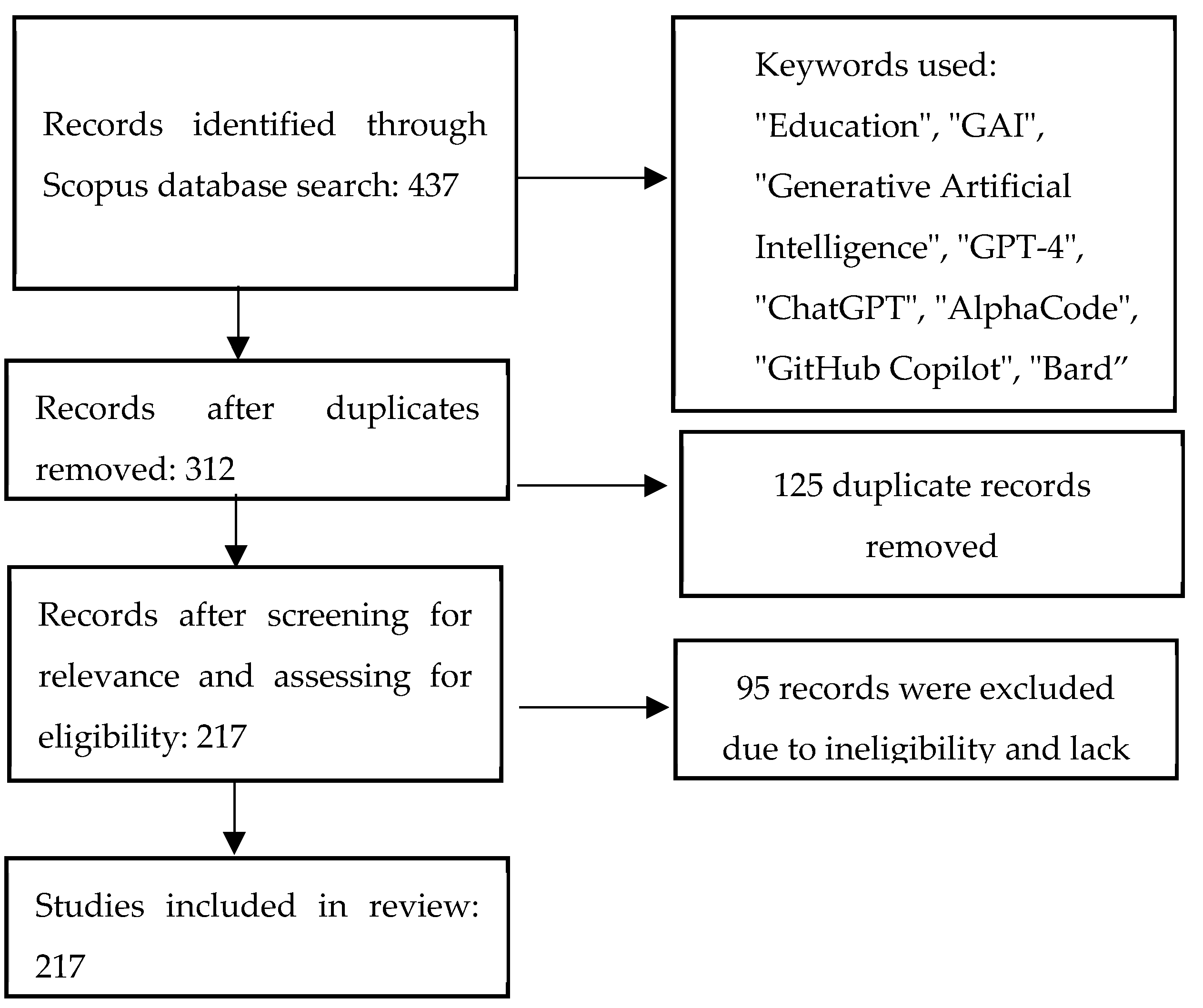
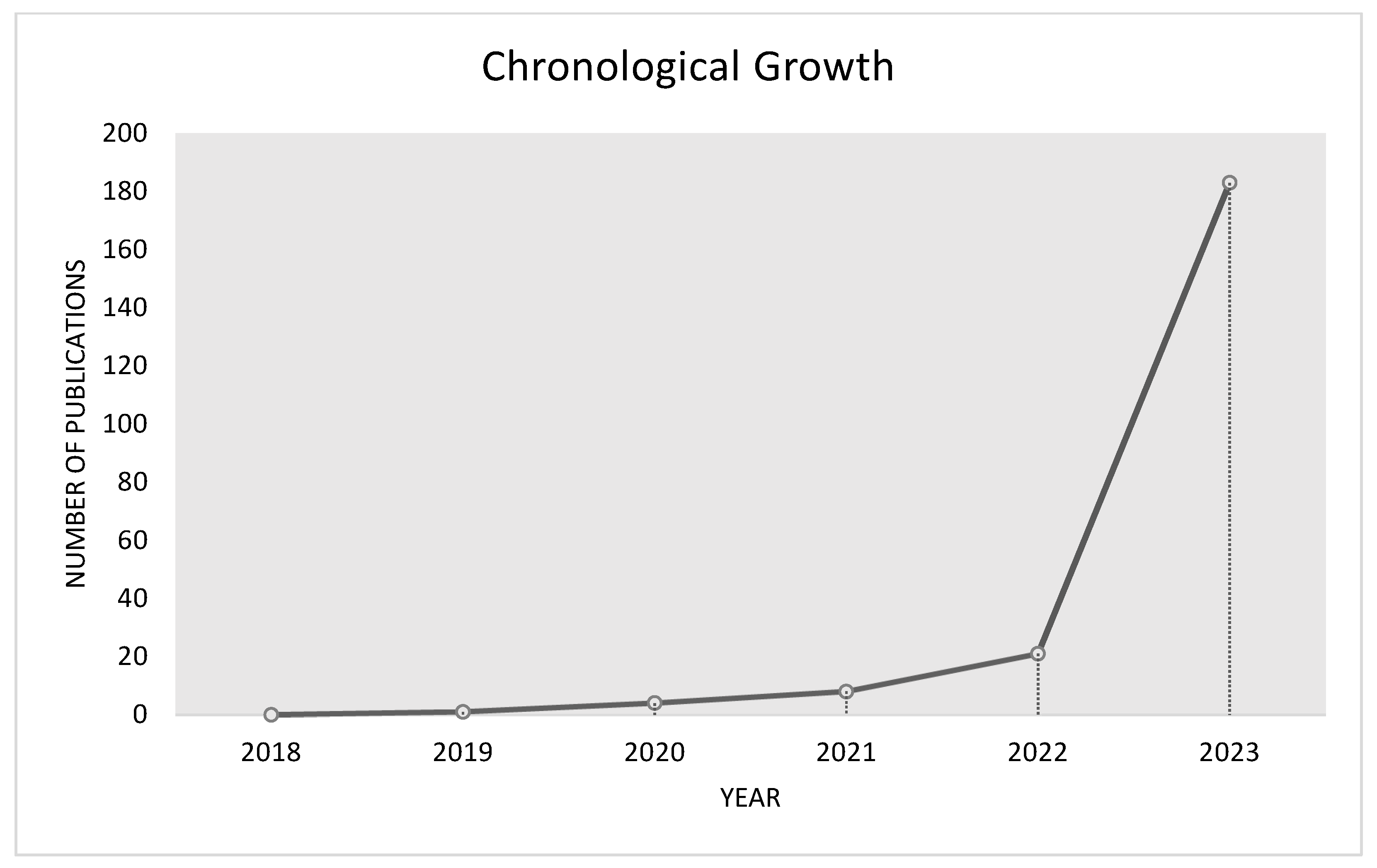
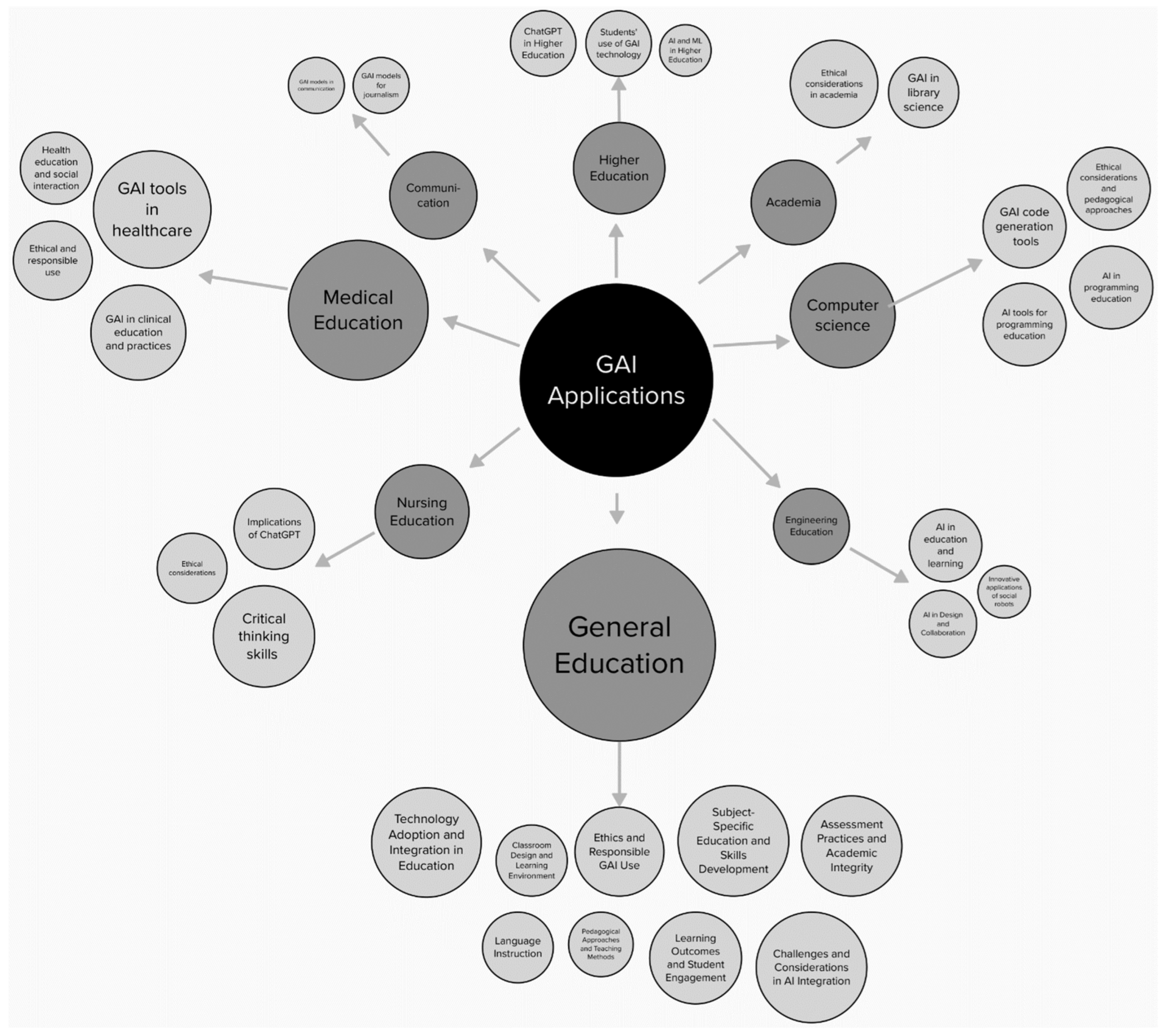
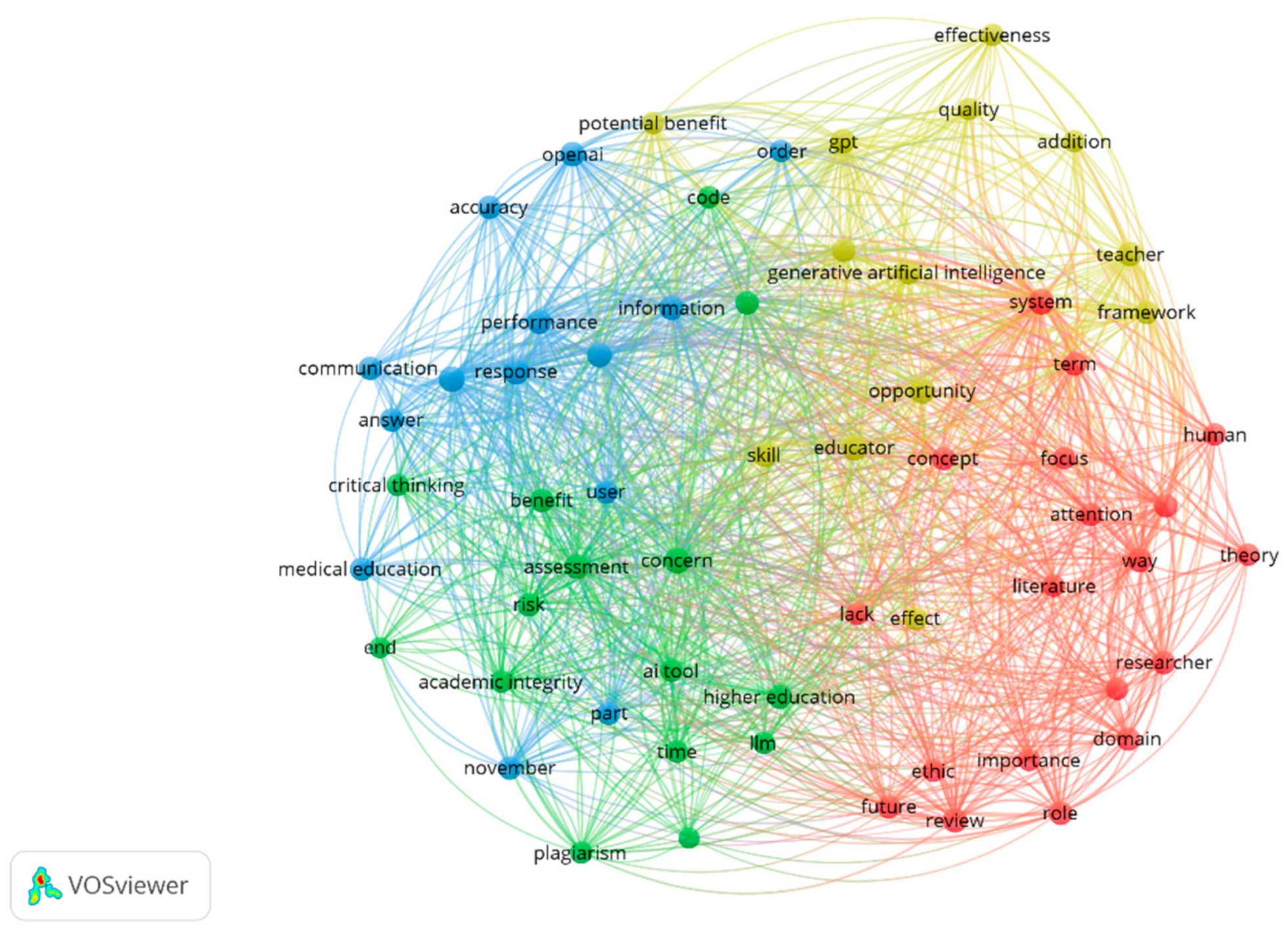
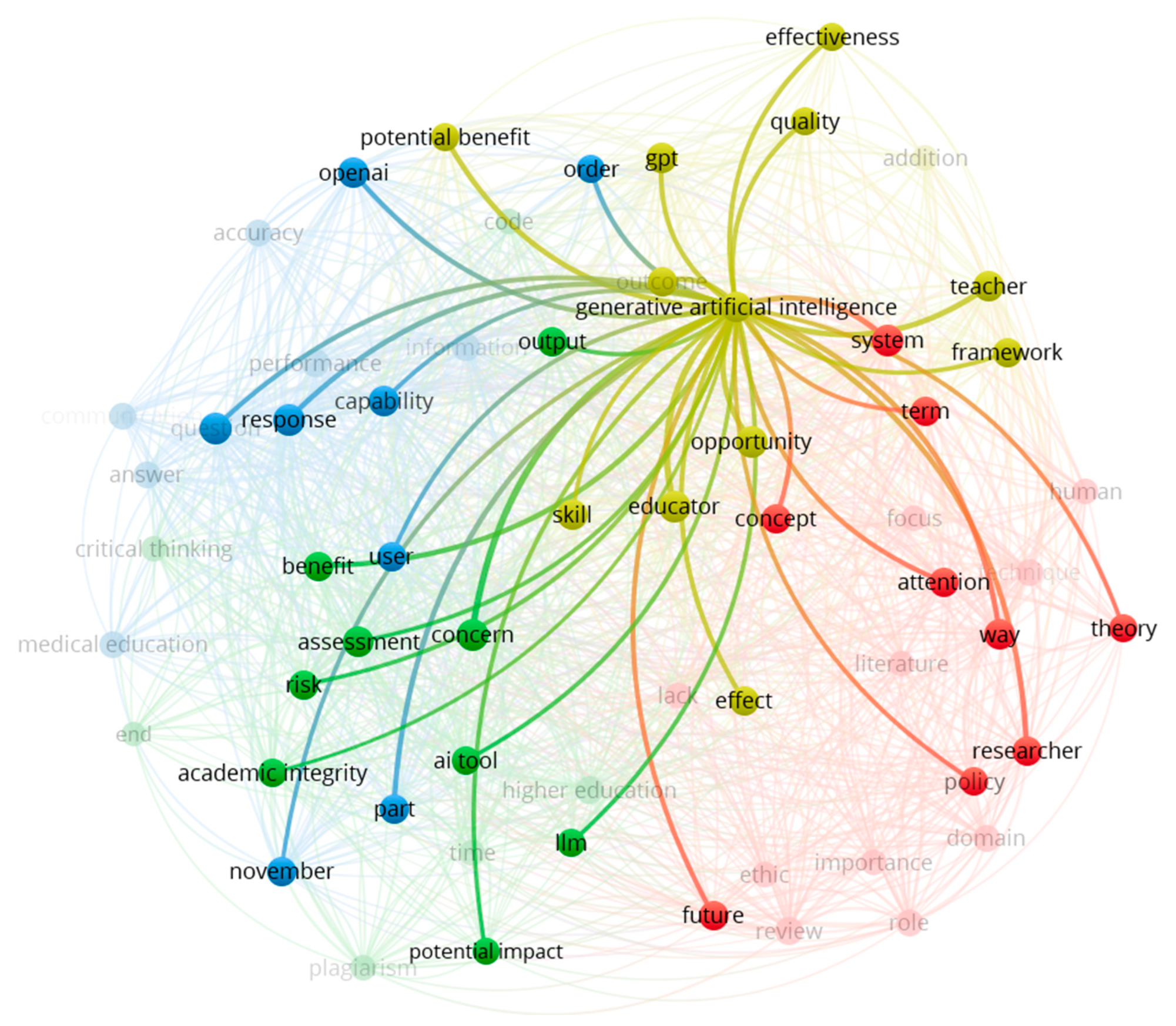
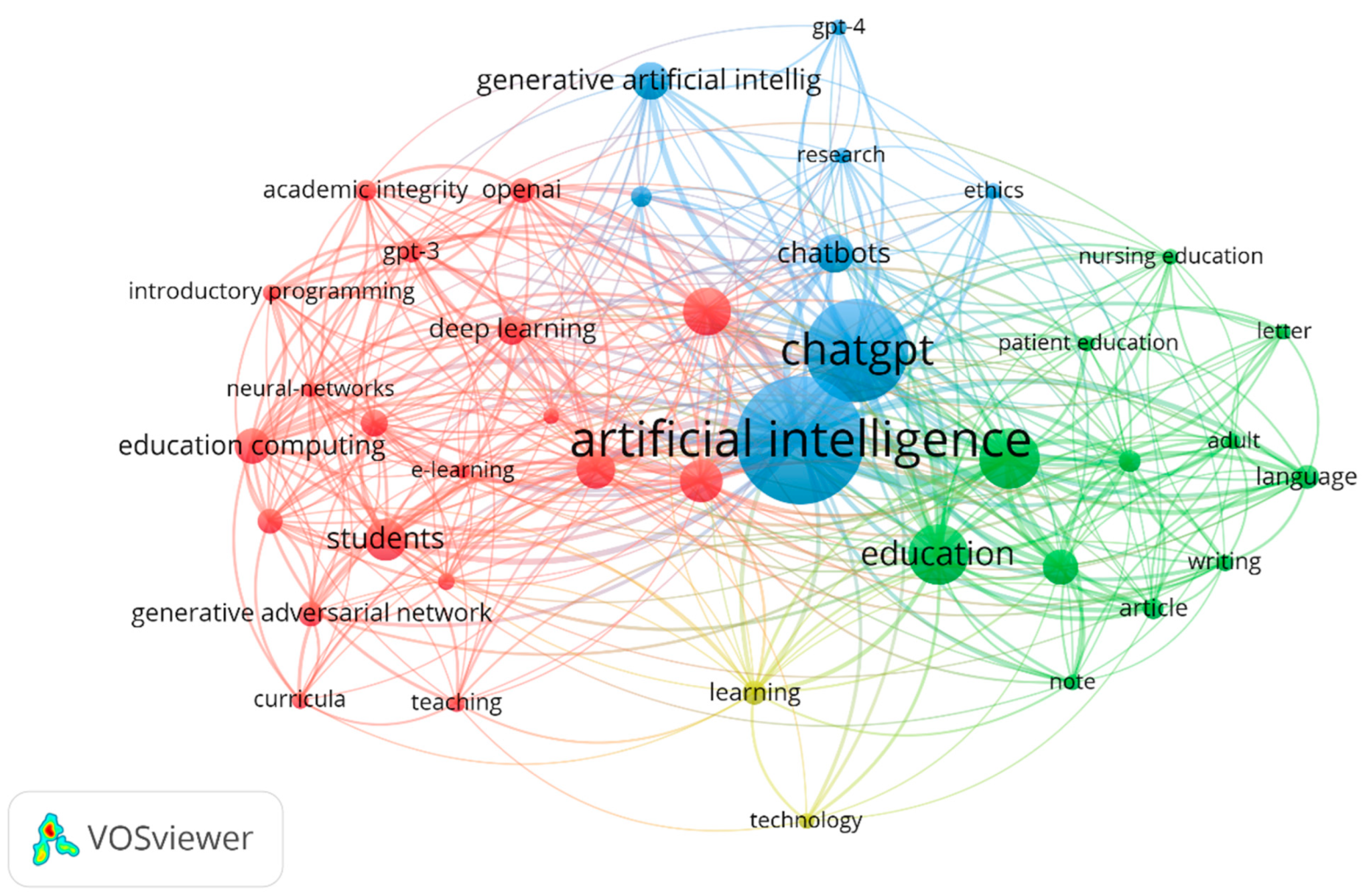
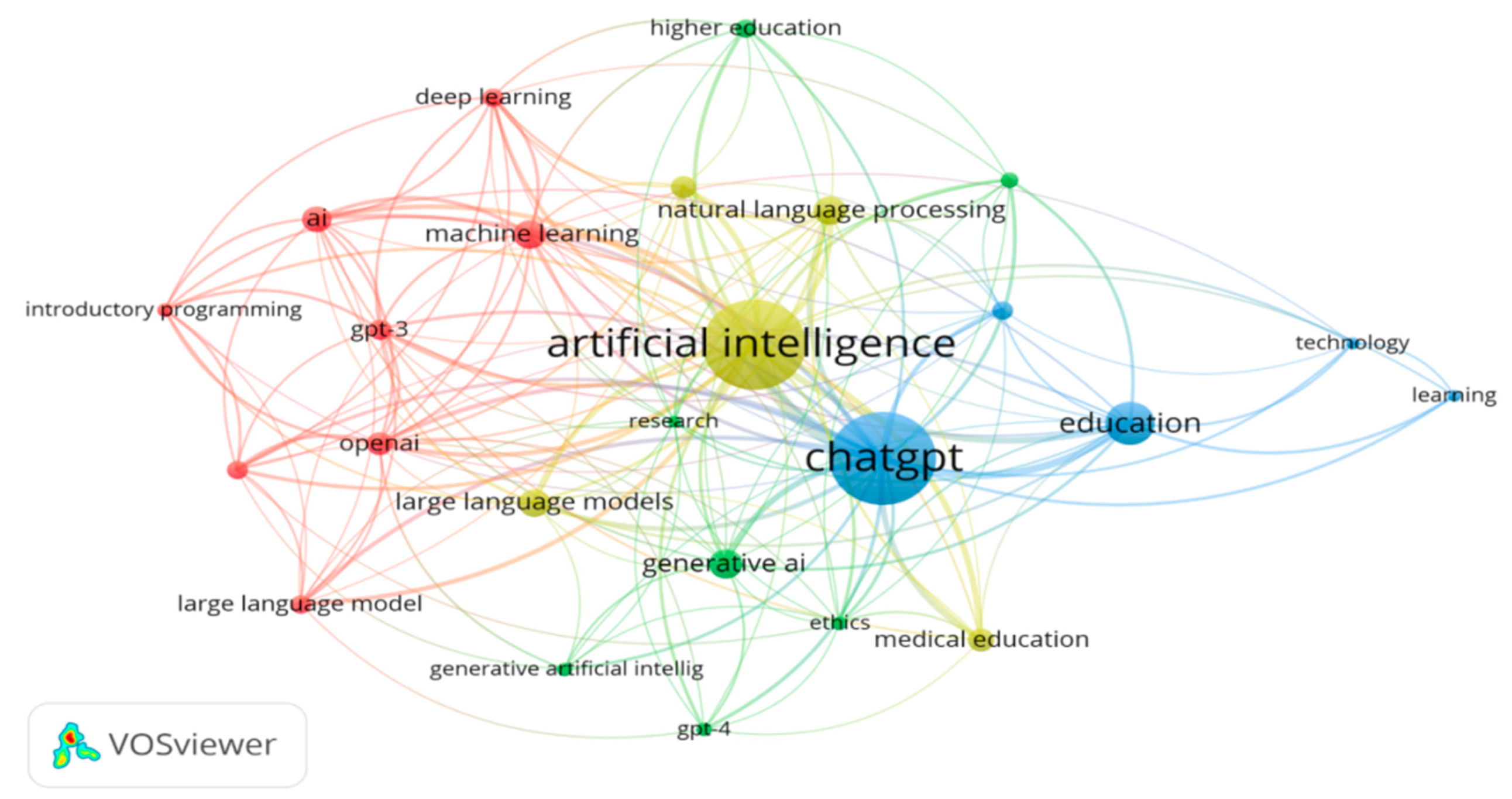
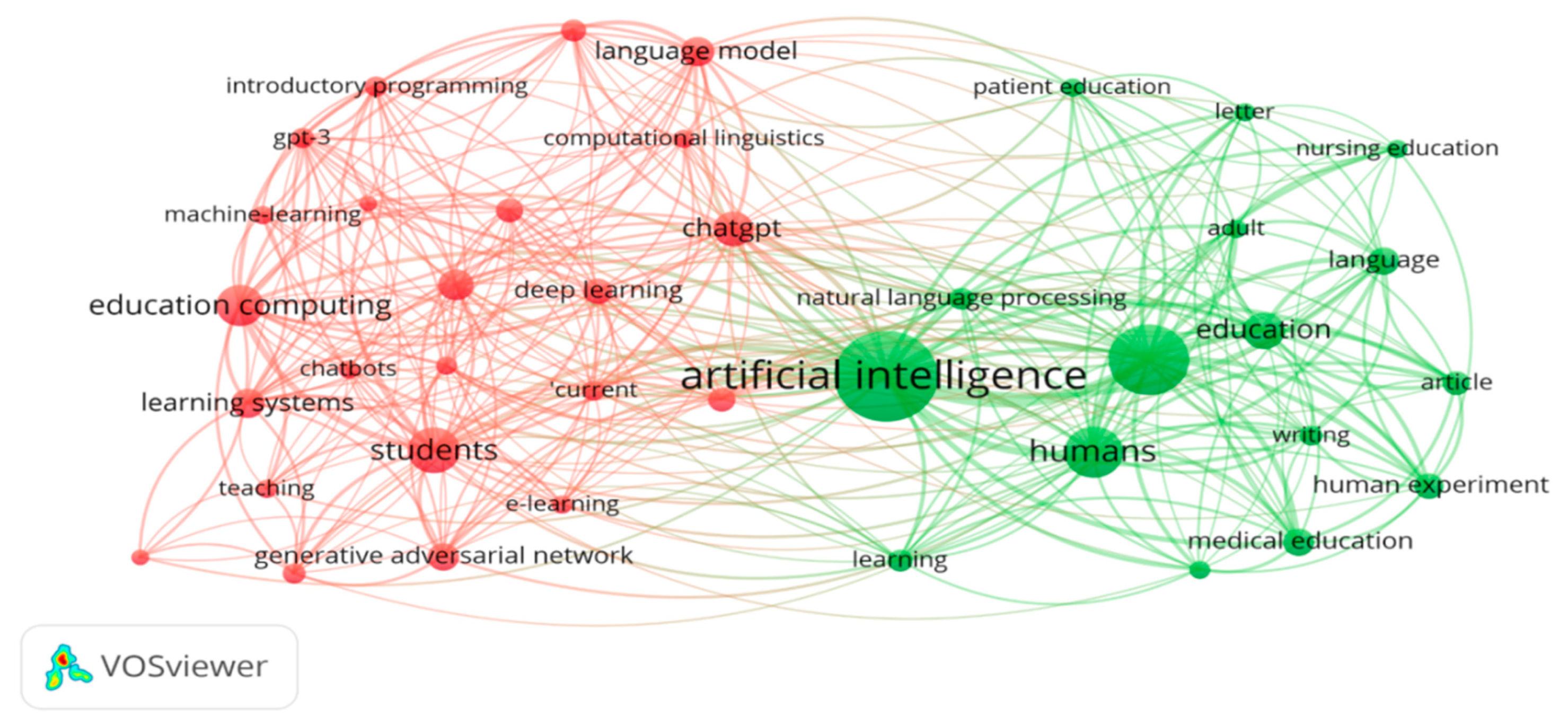
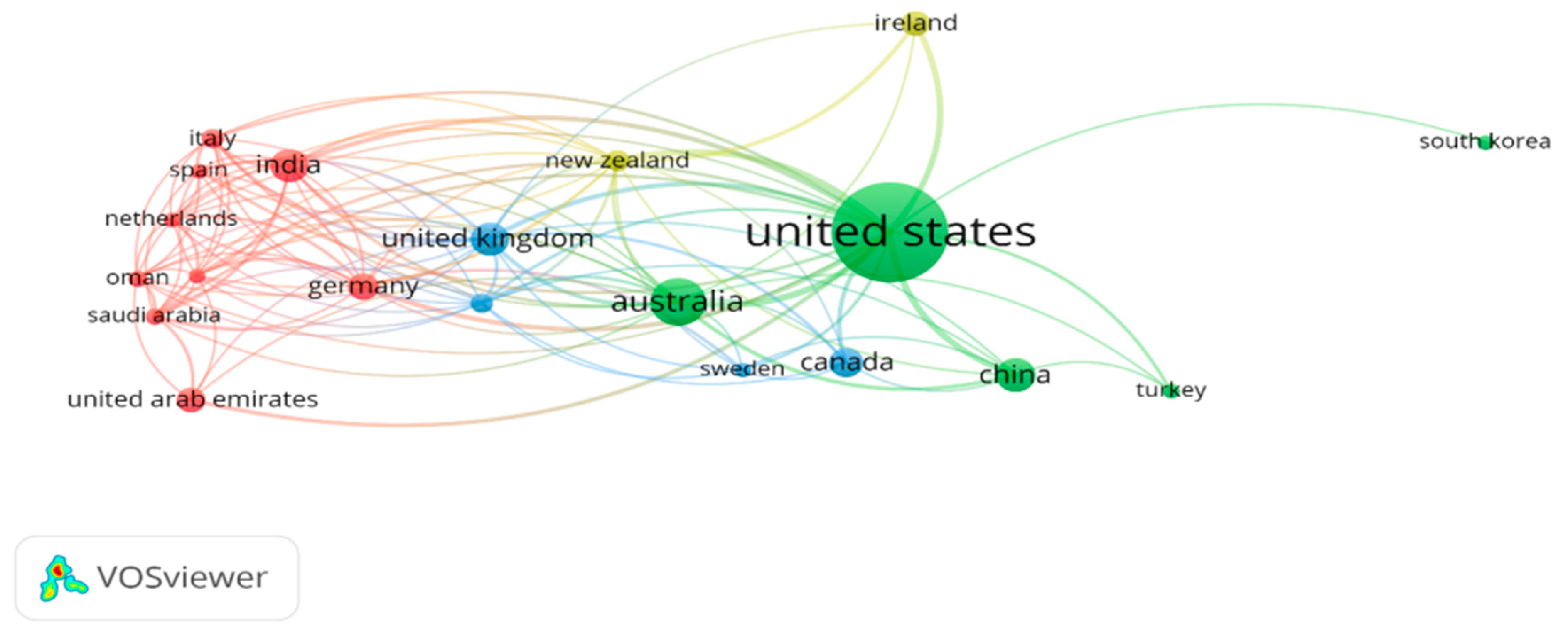
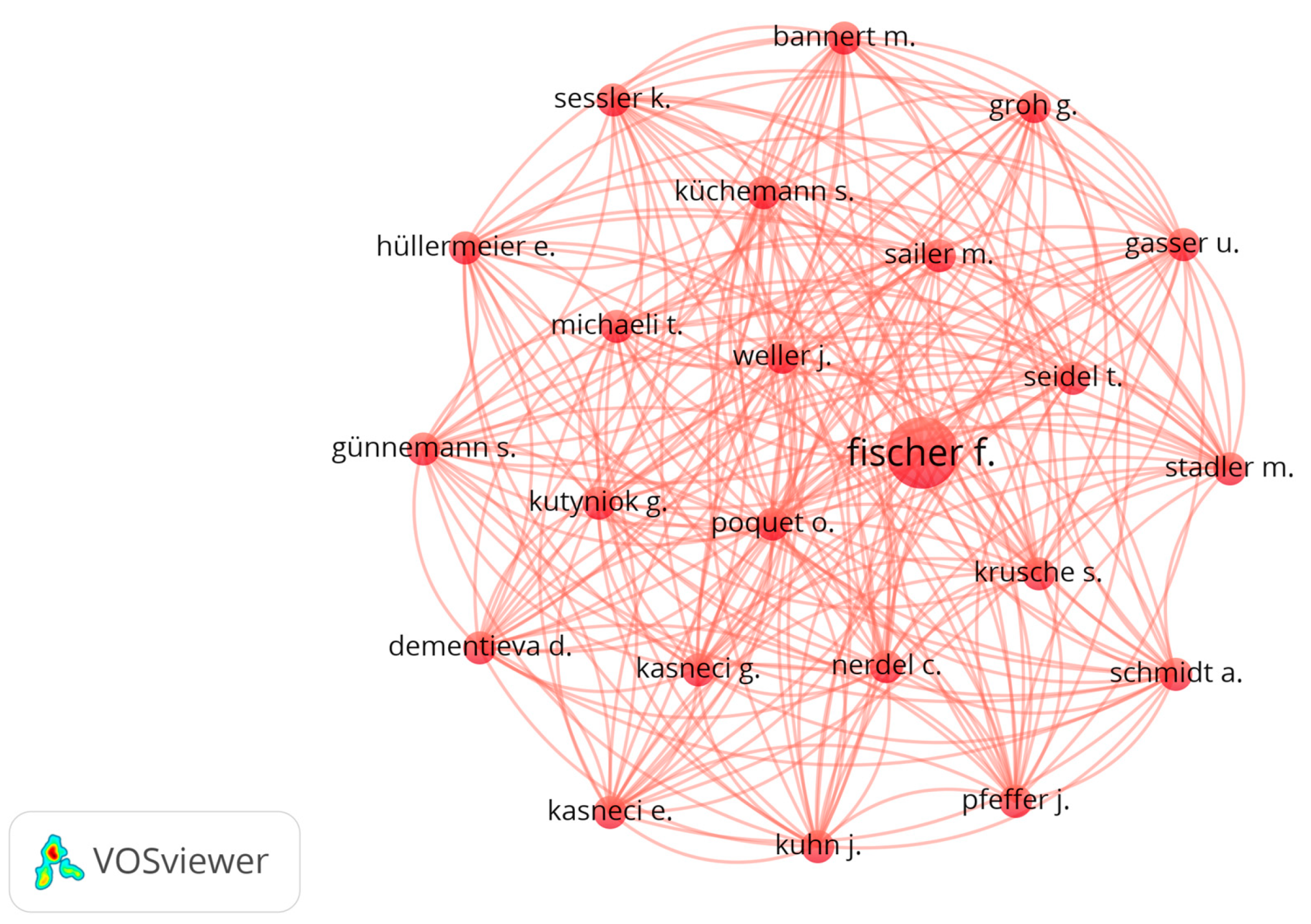
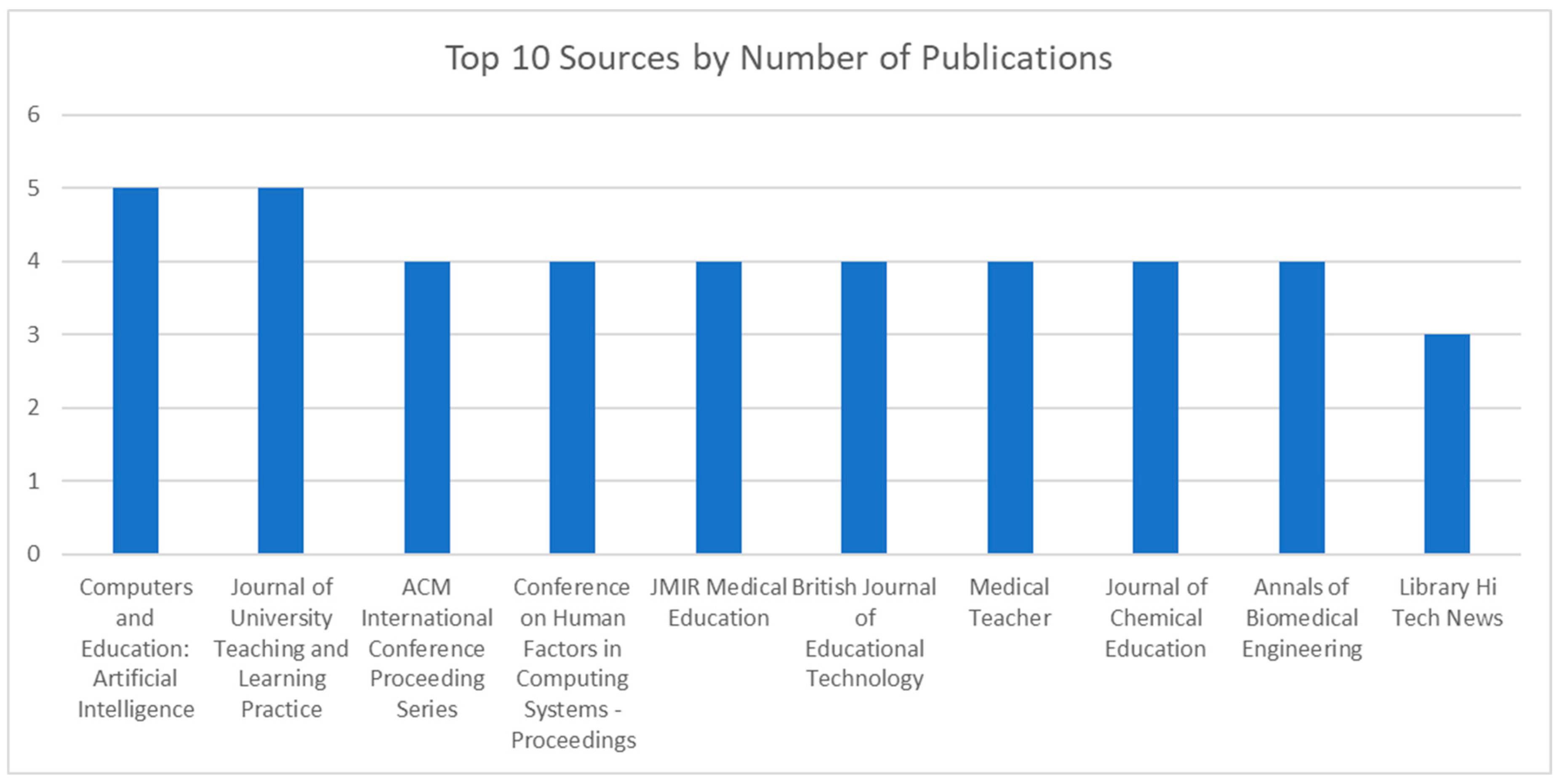
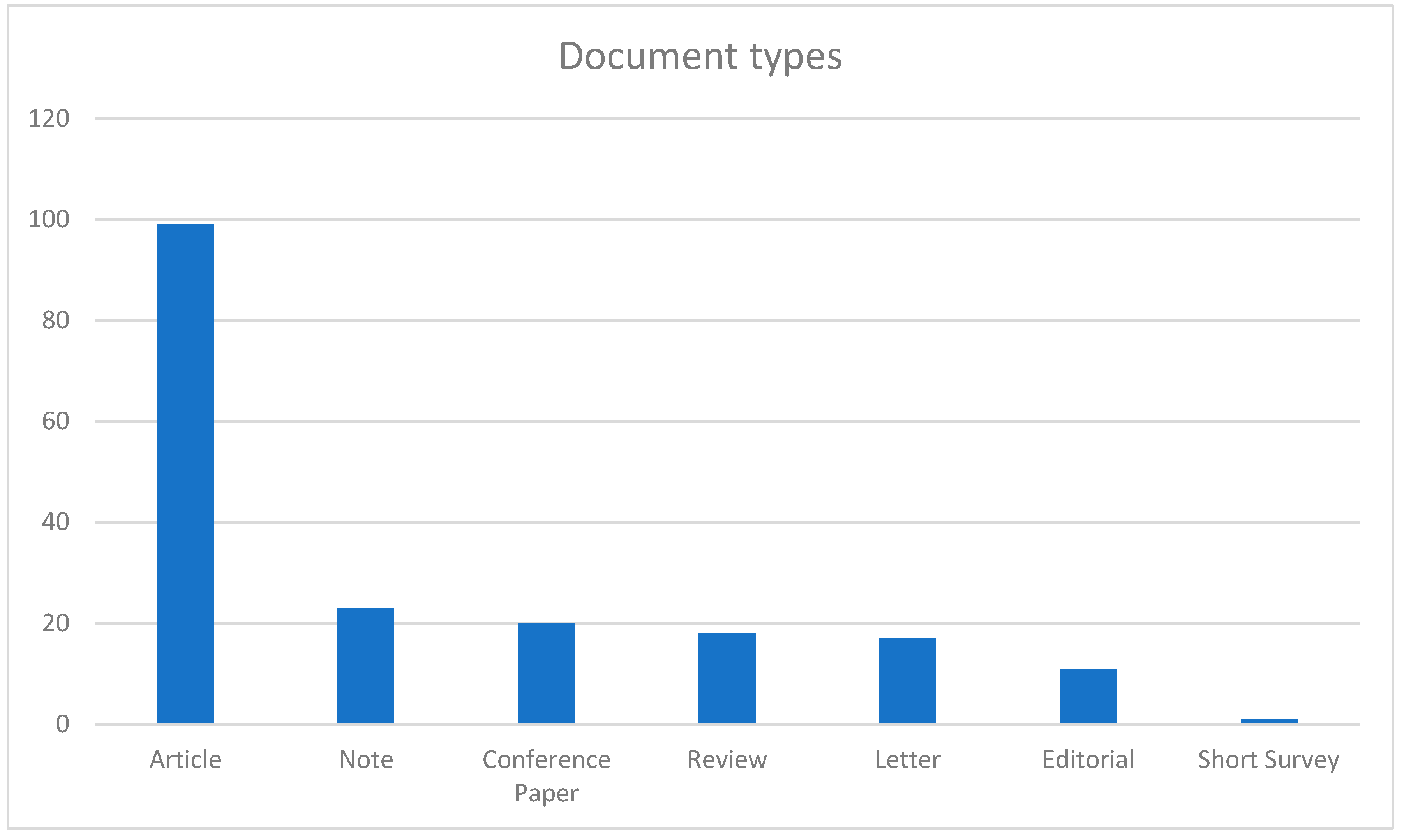
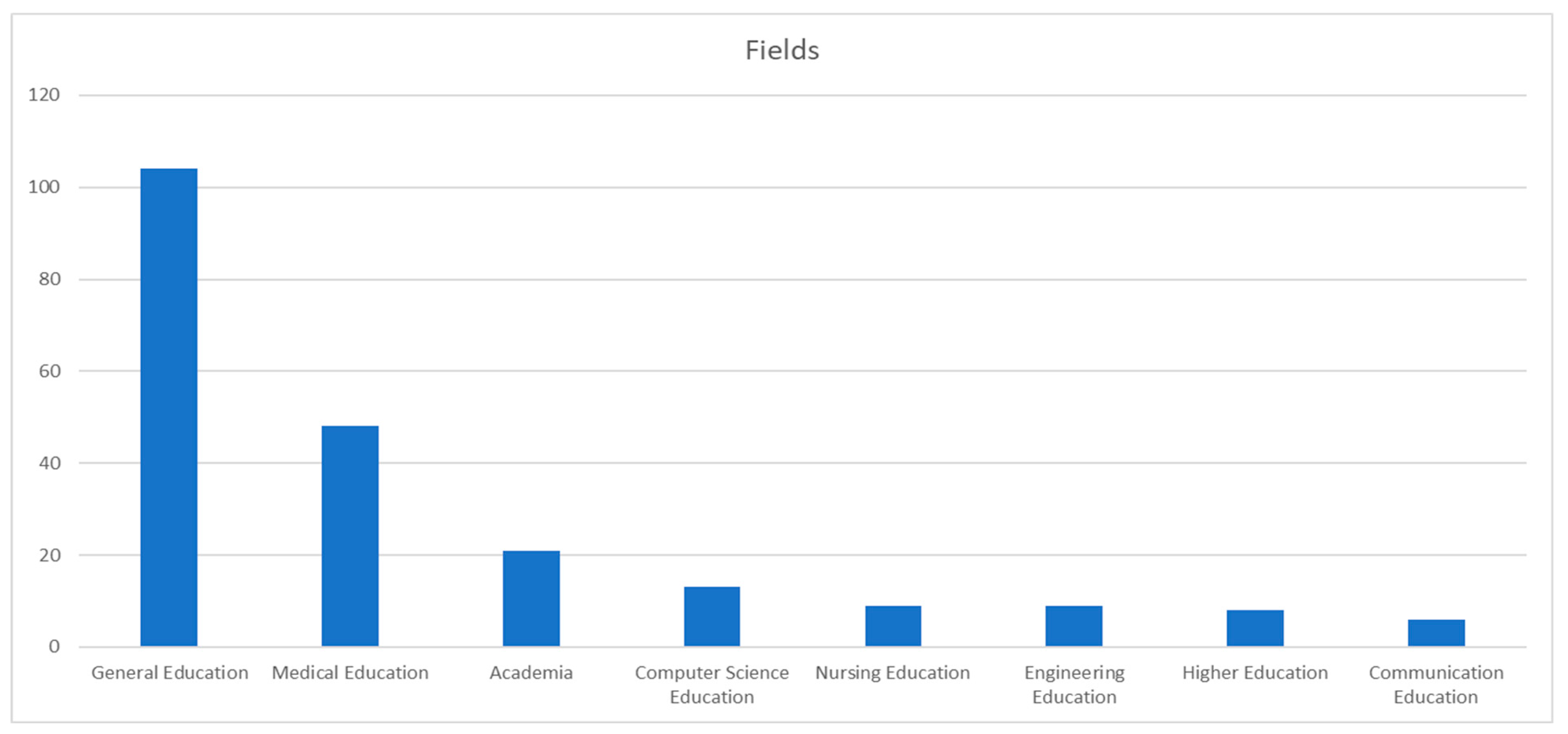
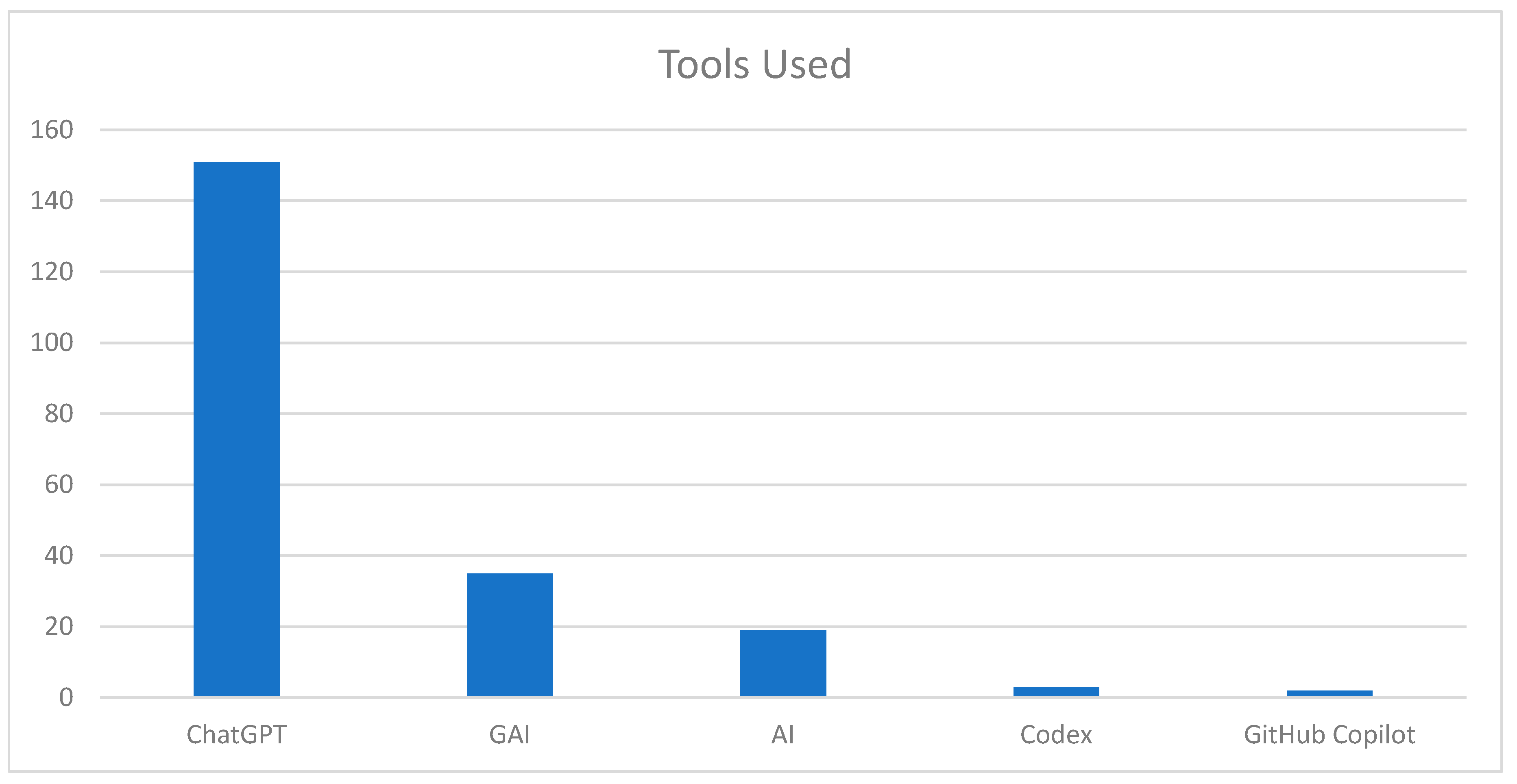
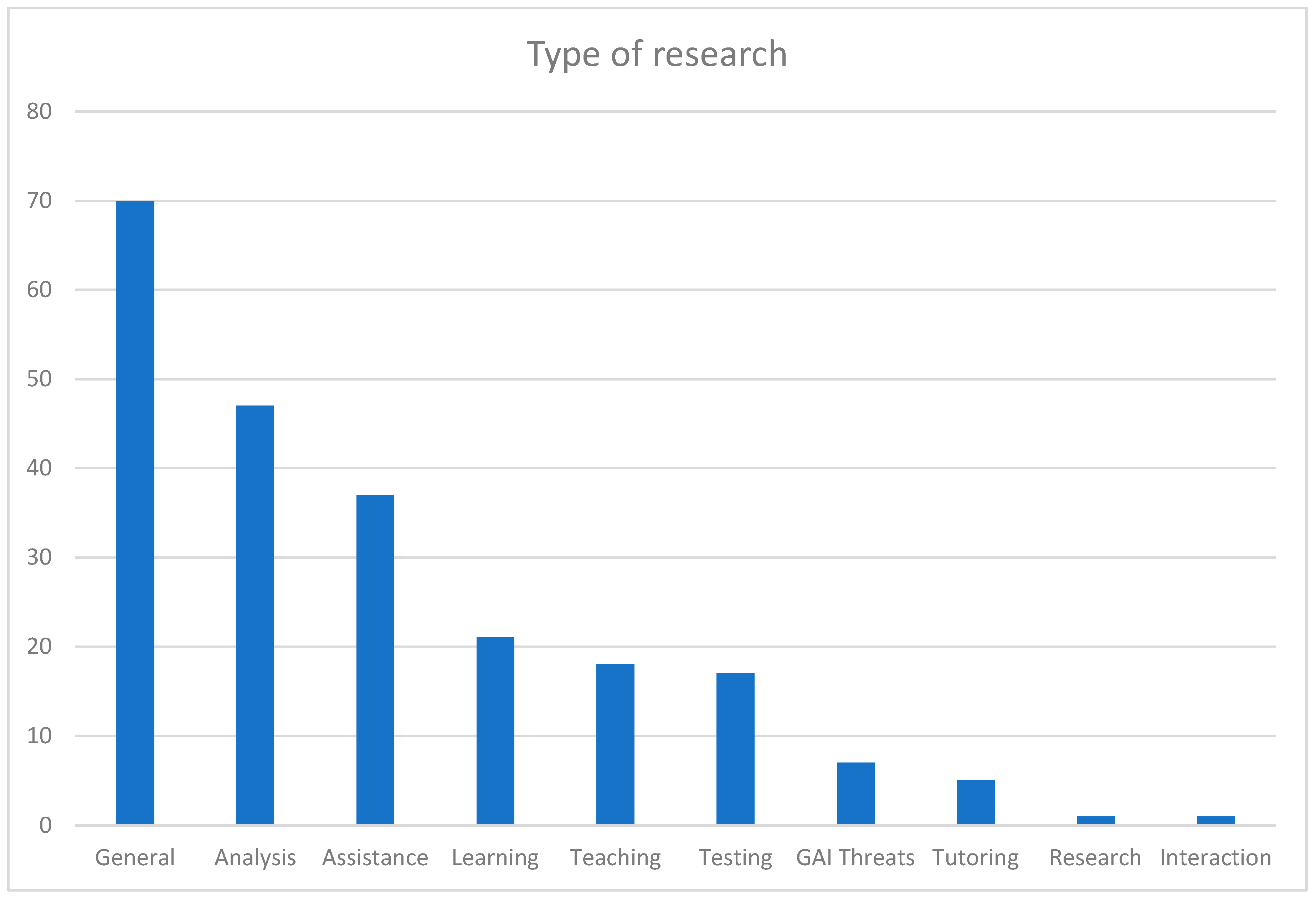
| Themes | Authors | Focus |
|---|---|---|
| Implications and potential of GAI code generation tools in programming education | Jonsson and Tholander (2022) [16] | Highlights the transformative potential of generative machine learning in creative programming education, fostering both programming proficiency and creativity through students’ exploration of the tool’s inconsistent behavior. |
| Finnie-Ansley et al. (2022) [17] | Investigates the performance and implications of Codex, a deep learning model, in introductory programming, showcasing its ability to outperform students in problem-solving while raising considerations for computing education. | |
| MacNeil et al. (2022) [11] | Explores the potential of large language models (LLMs) in providing explanations for programming concepts, contributing to the understanding of LLMs’ role in enhancing learning experiences. | |
| Denny et al. (2023) [18] | Investigates Copilot, an AI-powered code generation tool, emphasizing its problem-solving capabilities and discussing prompt engineering as a means to enhance computational thinking skills. | |
| Kazemitabaar et al. (2023) [19] | Demonstrates the positive influence of AI code generators, like OpenAI Codex, on novice programmers, highlighting improvements in performance, computational thinking skills, and motivation. | |
| Exploration and utilization of AI tools for programming education | Savelka et al. (2023) [20] | Investigates the effectiveness of generative pre-trained transformer (GPT) models in answering code-related multiple-choice questions, highlighting the challenges faced by GPT models in code analysis and reasoning. |
| Wermelinger (2023) [21] | Focuses on GitHub Copilot, an AI-powered programming assistant, evaluating its performance and limitations in code generation, explanation provision, test generation, and bug fixing. | |
| Ethical considerations and pedagogical approaches in AI education | Becker et al. (2023) [22] | Emphasizes the need for collaborative efforts to explore the implications and effectiveness of AI-driven code generation tools in computing education, highlighting the importance of shaping their trajectory. |
| Jacques (2023) [23] | Challenges the notion that AI-generated coding tools render human programming obsolete, advocating for a reevaluation of teaching methods that foster problem-solving, critical thinking, and communication skills. | |
| Raji et al. (2021) [24] | Delves into the ethical considerations in AI education and proposes a shift toward a collaborative and holistic pedagogy that bridges the gap between computer science and humanities and social sciences. | |
| Integration of AI technologies in programming education | Yilmaz and Yilmaz (2023) [25] | Explores the incorporation of ChatGPT into programming education and highlights its positive impact on computational thinking skills, programming self-efficacy, and student motivation. |
| Cortinas-Lorenzo and Lacey (2023) [26] | Addresses the need for transparency and interpretability in affective computing systems, highlighting the challenges associated with multimodal data, context integration, and interaction capturing. |
| Themes | Authors | Focus |
|---|---|---|
| Transformative role of AI in education and learning | Marquez et al. (2023) [27] | Emphasizes the potential of integrating product-based learning strategies and AI text generation models in biobased materials education, showcasing how this approach promotes active participation, problem-solving skills, and the generation of sustainable solutions. |
| Humphry and Fuller (2023) [28] | Demonstrates the utility of ChatGPT in revolutionizing chemistry education by effectively generating discussion sections for laboratory reports, highlighting its potential to improve student learning experiences and streamline the report writing process. | |
| Sánchez-Ruiz et al. (2023) [29] | Investigates ChatGPT’s impact on blended learning in engineering education, particularly mathematics. The study reveals that the integration of ChatGPT positively influences students’ critical thinking abilities, problem-solving skills, and collaborative work. However, it also raises concerns about potential effects on the development of lateral competencies, highlighting the need for adaptive teaching strategies in blended learning environments. | |
| Nikolic et al. (2023) [30] | Analyzes the impact of ChatGPT on assessment practices in engineering education. | |
| AI in design and collaboration | Gmeiner et al. (2023) [31] | Identifies challenges faced by designers when collaborating with AI-based design tools, including difficulties in understanding and adjusting AI-generated outputs and effectively communicating design objectives. |
| Chen et al. (2020) [32] | Sheds light on the transformative influence of AI in engineering design education, enabling the realization of previously unattainable solutions and concepts. | |
| Galdon et al. (2021) [33] | Presents an operational framework that harnesses abductive reasoning and probabilistic knowledge to enrich design and engineering education. The study showcases the framework’s potential in fostering creative engagement with knowledge and generating impactful solutions, emphasizing the necessity of reframing probabilistic knowledge and embracing transformative approaches to address real-world uncertainties and challenges. | |
| Innovative applications of social robots | Elfaki et al. (2023) [34] | Introduces a cloud-based framework aimed at augmenting the intelligence and autonomy of social robots in engineering education. The study showcases the feasibility and potential of this framework, empowering social robots to showcase heightened capabilities through the utilization of cloud computing and clustering. |
| Publications | Authors | Focus |
|---|---|---|
| The integration of GAI tools such as ChatGPT in higher education | Konecki et al. (2023) [35] | Conducts a comprehensive examination of ChatGPT’s role as an educational aid, providing insights into its benefits and limitations. |
| Eager and Brunton (2023) [36] | Focuses on the broader implications of LLMs and conversational-style GAI on pedagogy. They emphasize the importance of implementing effective plagiarism detection mechanisms, fostering supportive learning environments, and offering faculty development programs to ensure the responsible integration of AI in teaching and learning. | |
| Chaudhry et al. (2023) [37] | Intensively examines the impact of ChatGPT on learning outcomes and academic integrity in undergraduate degree programs. The study evaluates ChatGPT’s performance in handling assignments and compares it to high-achieving students. Additionally, the effectiveness of plagiarism detection tools is assessed in the context of ChatGPT usage. The findings highlight the limitations of ChatGPT in its ability to fully replace human performance and underscore the need for a reevaluation of student evaluation approaches in light of AI-based tools. | |
| Students’ acceptance and use of GAI technology in higher education | Iskender (2023) [38] | Addresses the ethical and pedagogical considerations of GAI in higher education and conducted an interview with ChatGPT to delve into its impact on the realm of higher education and academic publishing. The interview sheds light on ChatGPT’s potential in grading and supporting students, acknowledging its usefulness in certain educational contexts. However, it also raises crucial concerns about potential risks, such as the possibility of diminishing critical thinking skills and exacerbating educational inequalities. |
| Strzelecki (2023) [39] | Delves into the adoption and use of ChatGPT among higher education students, developing a model based on technology adoption theory. The study identifies key predictors such as habit, performance expectancy, and hedonic motivation in determining students’ acceptance and usage of ChatGPT. | |
| Stojanov (2023) [40] | Presents an autoethnographic study exploring the utilization of ChatGPT as a learning aid. The study underscores the potential benefits of ChatGPT while acknowledging its limitations, including occasional superficiality and inconsistency in generated answers. It emphasizes the need for caution and further research to fully understand the implications of incorporating ChatGPT in educational contexts. | |
| The applications of AI and ML in higher education | Pinto et al. (2023) [41] | Conducts a systematic literature review to shed light on the diverse uses of ML in higher eduction. The review highlights the prediction of academic performance and employability as the most extensively studied application of ML in higher education. |
| Publications | Authors | Focus |
|---|---|---|
| The integration of GAI tools in healthcare | Sallam et al. (2023) [9] | Investigates the potential benefits and limitations of incorporating ChatGPT into medical fields. The study reveals the promising advantages of ChatGPT, such as personalized learning, clinical reasoning support, and better comprehension of complex concepts in medical education. It highlights concerns related to data privacy, potential bias in generated content, and possible negative effects on critical thinking and communication skills. |
| Waisberg et al. (2023) [42] | Investigates the potential applications of GPT-4 in neurosurgery, revealing its ability to enhance precision and effectiveness in neurosurgical practices, leading to improved patient outcomes and advancements in the field. | |
| Sevgi et al. (2023) [43] | Assesses the reliability of ChatGPT in neurosurgical education, pointing out that while it provides interesting responses, its credibility is compromised by the lack of citations for scientific queries, suggesting caution in relying solely on ChatGPT as an educational resource. | |
| Šlapeta (2023) [44] | Explores the advantages of integrating large language models, including ChatGPT, in parasitology education, highlighting their potential to improve learning outcomes and facilitate knowledge acquisition in the field. | |
| Huh (2023) [45] | Compares ChatGPT’s knowledge and interpretive abilities with those of medical students in Korea in parasitology, revealing its inferior performance and indicating the need for further refinement in specialized medical contexts. | |
| Dolezal et al. (2023) [46] | Investigates the use of deep neural networks and conditional generative adversarial networks (cGANs) to generate synthetic histology for tumor classification, showcasing its value as an educational tool for enhancing understanding of tumor biology. | |
| Skalidis et al. (2023) [47] | Examines ChatGPT’s performance in answering questions from a post-graduate exam in core cardiology, demonstrating its impressive success in handling higher-level examination content and raising discussions on its potential applications in diverse educational contexts within cardiology. | |
| The applications of GAI in clinical education and practices | Corsello and Santangelo (2023) [48] | Discusses the potential impact of ChatGPT on future pediatric research, highlighting positive effects such as improved clinical decision-making and enhanced medical education. However, the study also addresses concerns about bias, fairness, and ethical considerations associated with GAI utilization. |
| Lyu et al. (2023) [49] | Investigates the feasibility of utilizing ChatGPT for translating radiology reports into plain language, revealing its effective translation capabilities while noting occasional occurrences of random or oversimplified responses that require attention. | |
| Abdel-Messih and Kamel Boulos (2023) [50] | Demonstrates ChatGPT’s ability to successfully pass the United States Medical Licensing Examination (USMLE) by effectively answering queries related to clinical toxicology, showcasing its potential in this domain. | |
| Oh et al. (2023) [51] | Explores the feasibility of integrating ChatGPT into surgical education and training, acknowledging its successful translation outcomes in radiology reports while also recognizing the need to address occasional occurrences of random or oversimplified responses. | |
| Lee et al. (2023) [52] | Discusses the implications of GPT-4 for a chatbot specifically tailored for the field of medicine. The study examines the potential impacts of this well-educated chatbot on the practice of medicine. | |
| The potential of GAI in health education and social interaction | Yang et al. (2023) [53] | Focuses on the utilization of ChatGPT in assisting children with Down syndrome, conducting a literature review to explore its advantages and limitations in various domains for individuals with this condition. It highlights the significance of ChatGPT as a valuable tool for promoting cognitive development, education, and social interaction, catering to the unique requirements of children with Down syndrome. |
| Wang et al. (2023) [54] | Explores the role of GAI in pandemic response and future medicine and conducts a comprehensive review of the potential applications of AI and GAI in the prevention and treatment of the COVID-19 pandemic. | |
| The ethical considerations and responsible use of GAI in healthcare | Cascella et al. (2023) [55] | Investigates the potential applications and limitations of ChatGPT in healthcare, emphasizing the need to educate stakeholders about the appropriate utilization of AI-based language models in medicine while addressing the ethical challenges they may present. |
| Gupta et al. (2023) [56] | Examines the use of ChatGPT in generating innovative ideas in plastic surgery, highlighting its potential to contribute to research and support various aspects of patient care. However, ethical considerations must be taken into account to ensure its responsible and beneficial application. | |
| Masters (2023) [57] | Addresses concerns about the improper utilization of ChatGPT by students and academics, emphasizing the importance of addressing this issue to prevent misuse and mitigate potential negative consequences. |
| Publications | Authors | Focus |
|---|---|---|
| Potential and implications of ChatGPT | Choi et al.’s (2023) [58] | Examines the effects of ChatGPT on nurse education, highlighting the importance of striking a balance between AI integration and human interaction to ensure comprehensive learning experiences. |
| Irwin et al. (2023) [59] | Discusses the broader implications of ChatGPT in nursing and midwifery practice, stressing the potential benefits it brings alongside the challenges in implementing this transformative technology. | |
| Ethical considerations of using ChatGPT in nursing education | Abdulai and Hung (2023) [60] | Delves into the ethical considerations of using ChatGPT in nursing education, emphasizing the significance of aligning AI integration with nursing’s core values to maintain the profession’s unique identity. |
| Fostering critical thinking skills among nursing students. | Seney et al. (2023) [61] | Sheds light on ChatGPT’s role in enhancing clinical judgment in nursing education and proposes a thoughtful teaching strategy to address its limitations in generating NCLEX-style questions. |
| Ahmed (2023) [62] | Takes a closer look at ChatGPT’s transformative impact on personalized learning and clinical decision-making for nurses while addressing the ethical considerations surrounding its use. | |
| Lo (2023) [63] | Introduces the CLEAR Framework, a valuable tool for equipping nursing students with critical thinking skills, enabling them to engage effectively with AI language models and promoting responsible AI use in nursing education. |
| Publications | Authors | Focus |
|---|---|---|
| GAI models are revolutionizing in the context of communication. | Wang (2022) [64] | Focuses on machine translation, specifically examining the use of generative adversarial network-based neural machine translation models to improve Chinese–English translation accuracy and naturalness. |
| Santandreu-Calonge et al. (2023) [65] | Investigates the advantages of natural language processing tools, like ChatGPT, in addressing challenges such as jargon and coordination issues. The authors emphasize the importance of combining AI technologies with human expertise to achieve effective communication and enhanced patient outcomes. | |
| GAI models are revolutionizing journalism | Pavlik (2023) [66] | Critically analyzes ChatGPT and discusses its implications. The analysis highlights the transformative capacity of GAI in shaping the future of journalism and media, highlighting both the opportunities and challenges that arise from the integration of AI in these fields. |
| Feng et al. (2023) [67] | Conducts a data-driven analysis using Twitter and Reddit. Their research uncovers the profound influence of ChatGPT on streaming media and highlights the potential of integrating ChatGPT with visual generative models. |
| Publications | Authors | Focus |
|---|---|---|
| GAI and ethical considerations in academia | Alqahtani et al. (2023) [68] | Highlights the transformative impact of (GAI) models, such as GPT-4 and BARD, in higher education and research. They explore the potential benefits of these technologies, including text generation, data analysis, literature review, and educational support. However, the authors also emphasize the importance of addressing ethical concerns and algorithmic biases to ensure responsible and effective utilization of GAI in academia. |
| Cotton et al. (2023) [69] | Sheds light on the benefits and challenges associated with the use of ChatGPT in higher education. The authors emphasize the advantages of increased student engagement and accessibility while addressing concerns related to academic dishonesty. Strategies to detect and prevent cheating are explored, highlighting the need for a proactive and ethical approach to integrating AI tools. | |
| Currie (2023) [70] | Focuses on the impact of ChatGPT on academic integrity in nuclear medicine and radiology, acknowledging its potential while highlighting limitations, such as errors and fabrications. Emphasizes the ethical and responsible integration of ChatGPT. | |
| Dergaa et al. (2023) [71] | Examines the prospects and potential threats of ChatGPT in academic writing, emphasizing the need to redefine norms and adjust information expectations for ethical utilization. | |
| Perkins (2023) [72] | Explores the implications of AI tools like ChatGPT on academic integrity during formal assessments, addressing concerns about undetectable original content generation. The importance of transparent student use and updates to academic integrity policies in higher education institutions are emphasized throughout these papers. | |
| GAI in library science | Inamdar (2023) [73] | Conducts a comprehensive investigation into the impact of artificial intelligence text generators (AITGs) on library services, resources, and staff roles, highlighting their potential to enhance various aspects of library operations and accessibility. |
| Frederick (2023) [74] | Focuses on information environments and explores the role of ChatGPT in libraries, analyzing current discussions and historical developments. The paper uncovers the potential risks and benefits associated with ChatGPT, providing valuable guidance for librarians to navigate the implications of this technology and emphasizing the importance of librarians acquiring knowledge about AI to adapt to changing information landscapes. |
| GAI Application | Authors | Focus |
|---|---|---|
| Technology Adoption and Integration in Education | Al Ghatrifi et al. (2023) [75], Geerling (2023) [76], Skavronskaya et al. (2023) [77], Elnozahy and El Khayat (2023) [78], Aydın and Ayhan Erdem (2022) [79], Cooper (2023) [80], Su and Yang (2023) [81], Murugesan and Cherukuri (2023) [82], Hsu and Ching (2023) [83], Mørch and Andersen (2023) [84], Gentile et al. (2023) [85], Jangjarat et al. (2023) [86], Tlili et al. (2023) [87], Lodge et al. (2023) [88], Chen et al. (2020) [89], Luo et al. (2023) [90], Kasneci et al. (2023) [91], Golovianko et al. (2023) [92], Ye and Bors (2022) [93]. |
|
| Classroom Design and Learning Environment | Karadag et al. (2022) [94], Vartiainen and Tedre (2023) [95], Zhai et al. (2023) [96], Sarr et al. (2020) [97]. |
|
| Assessment Practices and Academic Integrity | Geerling (2023) [76], Bauer et al. (2023) [98], Farrokhnia et al. (2023) [99], Howell and Potgieter (2023) [100], Huang and Khan (2023) [101], Ibrahim et al. (2023) [102], Sung et al. (2019) [103], Lo (2023) [104], Ajevski et al. (2023) [105], Johinke et al. (2023) [106]. |
|
| Language Instruction | Kovačević (2023) [107], Zhao and Song (2022) [108], Tang and Deng (2022) [109], O’Leary (2023) [110], Yan (2023) [111]. |
|
| Ethics and Responsible GAI Use | Kooli (2023) [13], Bearman and Ajjawi (2023) [112], Fernandez (2023) [113], Bahrini et al. (2023) [3], Ray (2023) [114], Singh and Singh (2023) [115], Danry et al. (2022) [116], Ali et al. (2021) [117]. |
|
| Subject-Specific Education and Skills Development | Adams et al. (2023) [118], Bearman and Ajjawi (2023) [112], Emenike and Emenike (2023) [119], Agathokleous et al. (2023) [120], Kooli (2023) [13], Hallsworth et al. (2023) [121], Megahed et al. (2023) [122], Ivanov and Soliman (2023) [123], Fergus et al. (2023) [124], Siche and Siche (2023) [125], Uddin et al. (2023) [126], Wolfert et al. (2022) [127]. |
|
| Learning Outcomes and Student Engagement | Wu and Yu (2023) [128], Muñoz et al. (2023) [129], Crawford et al. (2023) [130], Shoufan (2023) [131], Gardner and Giordano (2023) [132], Hemachandran et al. (2022) [133], Limo et al. (2023) [134], Alnaqbi and Fouda (2023) [135], Jeon and Lee (2023) [136], Dijkstra et al.(2023) [137], Pataranutaporn et al. (2022) [138]. |
|
| Challenges and Considerations in AI Integration | Shu et al. (2021) [139], Wardat et al. (2023) [140], Halaweh (2023) [141], Lim et al. (2023) [142], Hwang and Chen (2023) [143], Yu and Guo (2023) [144], Dwivedi et al. (2023) [145]. |
|
| Pedagogical Approaches and Teaching Methods | Javed et al. (2022) [146], Bauer et al. (2023) [98], Karaali (2023) [147], Lawrie (2023) [148], Robertson and Muirhead (2022) [149], Álvarez-Álvarez and Falcon (2023) [150]. |
|
| Rank | Term | Occurrences | Relevance Score |
|---|---|---|---|
| 1 | System | 39 | 0.8012 |
| 2 | Response | 38 | 1.4718 |
| 3 | Concern | 35 | 0.8416 |
| 4 | Question | 34 | 1.1378 |
| 5 | Opportunity | 30 | 0.8361 |
| 6 | GPT | 28 | 1.0504 |
| 7 | Information | 27 | 1.4886 |
| 8 | Assessment | 26 | 0.6512 |
| 9 | Way | 25 | 1.134 |
| 10 | Capability | 25 | 0.5872 |
| Rank | Keyword | Occurrences | Total Link Strength |
|---|---|---|---|
| 1 | Artificial intelligence | 111 | 97 |
| 2 | ChatGPT | 88 | 69 |
| 3 | Education | 41 | 37 |
| 4 | Education computing | 19 | 18 |
| 5 | Human | 41 | 41 |
| 6 | Humans | 26 | 26 |
| 7 | Machine learning | 21 | 18 |
| 8 | Medical education | 19 | 19 |
| 9 | Natural language processing | 19 | 18 |
| 10 | Students | 24 | 21 |
| Rank | Country | Documents | Citations | Total Link Strength |
|---|---|---|---|---|
| 1 | United States | 73 | 334 | 59 |
| 2 | Australia | 26 | 102 | 31 |
| 3 | United Kingdom | 15 | 89 | 29 |
| 4 | New Zealand | 8 | 67 | 27 |
| 5 | India | 15 | 98 | 20 |
| 6 | Germany | 11 | 75 | 19 |
| 7 | Hong Kong | 7 | 211 | 19 |
| 8 | Italy | 7 | 63 | 17 |
| 9 | Saudi Arabia | 6 | 40 | 17 |
| 10 | Switzerland | 5 | 45 | 16 |
| Rank | Author | Documents | Citations | Total Link Strength |
|---|---|---|---|---|
| 1 | Ali S. | 4 | 23 | 13 |
| 2 | Breazeal C. | 4 | 23 | 13 |
| 3 | Denny P. | 4 | 30 | 12 |
| 4 | Fischer F. | 3 | 30 | 22 |
| 5 | Becker B.A. | 3 | 29 | 12 |
| 6 | Dipaola D. | 3 | 23 | 12 |
| 7 | Finnie-Ansley J. | 3 | 29 | 12 |
| 8 | Luxton-Reilly A. | 3 | 29 | 12 |
| 9 | Prather J. | 3 | 29 | 12 |
| 10 | Cowling M. | 3 | 9 | 3 |
| Rank | Author | Documents | Citations | Total Link Strength |
|---|---|---|---|---|
| 1 | Hwang G.-J. | 2 | 162 | 3 |
| 2 | Chen X. | 1 | 162 | 3 |
| 3 | Xie H. | 1 | 162 | 3 |
| 4 | Zou D. | 1 | 162 | 3 |
| 5 | Thorp H.H. | 1 | 116 | 0 |
| 6 | Stokel-Walker C. | 1 | 51 | 0 |
| 7 | Chartash D. | 1 | 47 | 6 |
| 8 | Chi L. | 1 | 47 | 6 |
| 9 | Gilson A. | 1 | 47 | 6 |
| 10 | Huang T. | 1 | 47 | 6 |
Disclaimer/Publisher’s Note: The statements, opinions and data contained in all publications are solely those of the individual author(s) and contributor(s) and not of MDPI and/or the editor(s). MDPI and/or the editor(s) disclaim responsibility for any injury to people or property resulting from any ideas, methods, instructions or products referred to in the content. |
© 2023 by the authors. Licensee MDPI, Basel, Switzerland. This article is an open access article distributed under the terms and conditions of the Creative Commons Attribution (CC BY) license (https://creativecommons.org/licenses/by/4.0/).
Share and Cite
Bahroun, Z.; Anane, C.; Ahmed, V.; Zacca, A. Transforming Education: A Comprehensive Review of Generative Artificial Intelligence in Educational Settings through Bibliometric and Content Analysis. Sustainability 2023, 15, 12983. https://doi.org/10.3390/su151712983
Bahroun Z, Anane C, Ahmed V, Zacca A. Transforming Education: A Comprehensive Review of Generative Artificial Intelligence in Educational Settings through Bibliometric and Content Analysis. Sustainability. 2023; 15(17):12983. https://doi.org/10.3390/su151712983
Chicago/Turabian StyleBahroun, Zied, Chiraz Anane, Vian Ahmed, and Andrew Zacca. 2023. "Transforming Education: A Comprehensive Review of Generative Artificial Intelligence in Educational Settings through Bibliometric and Content Analysis" Sustainability 15, no. 17: 12983. https://doi.org/10.3390/su151712983
APA StyleBahroun, Z., Anane, C., Ahmed, V., & Zacca, A. (2023). Transforming Education: A Comprehensive Review of Generative Artificial Intelligence in Educational Settings through Bibliometric and Content Analysis. Sustainability, 15(17), 12983. https://doi.org/10.3390/su151712983










